At the end of 2015 we visited Ethiopia for Christmas with Wild
Frontiers and had a marvellous time. You can read about it here:
https://fatslowcow.uk/2015/Ethiopia%20Microdiary/index.html
In fact, we liked it so much, we thought we'd go back, but to see
something completely different: the Danakil Depression. This is one
of the lowest and hottest places on the entire Earth, and it's not
exactly known for its thriving tourist scene; so right up our
street, eh? WF aren't the only people who organise trips there, but
there's not exactly a huge number to choose from and they're a
company we know and like, so we made our booking and paid our
deposit to go in January 2017.
But a trip like this only appeals to, shall we say, the discerning
few, and the difficult logistics mean it's a luxury holiday price
for the exact opposite of luxury, and WF weren't able to get the
mininum number of six travellers needed to make it economically
viable so had to cancel. Obviously they would refund our deposit, or
alternatively if we liked, we could use it for a different trip and
they'd give us a 10% discount. We had a think and an email chat with
WF and decided we'd simply roll it forward to the same trip in 2018.
[But we still fancied somewhere a bit exotic for that year, so ended
up going to Bolivia in September. Yes, there's a blog for that too:
https://fatslowcow.uk/2017/Bolivia%20on%20Two%20Pictures%20a%20Day/index.html
]
But come the end of 2017, there was an incident where a German
tourist was shot and killed at Erta Ale, one of the locations we'd
be visiting. Local agents, including the leader on our previous
trip, whose judgement we would completely respect, were sure that
this was an isolated incident and the region was not unsafe. Indeed,
with the rapid response of the Ethiopian military, it was probably
even safer than normal. However, it's perhaps not surprising that it
put some people off travelling, and once again the tour had to be
cancelled.
[So we went to Oman instead:
https://fatslowcow.uk/2018/Oman%20Mini%20Photo-Diary/index.html ]
In 2019 we tried yet again to book for January 2020.
And this time... HURRAH! SUCCESS! WE'RE GOING!
Time for a photo-diary, I think.
23 January 2020

As is our custom, we begin our journeys whenever possible with a
seafood platter and a glass of something nice at the airport
terminal. But what am I holding in my left hand? Why it's a Water-to-Go
filter bottle. We're going to be pretty off-grid for a part of this
holiday, and WF are trying to discourage the use of bottled water
because of the huge environmental cost of the plastic waste. Fine by
us! As it happens, we don't normally buy bottled water at home
because we have a plumbed-in filter system ourselves. That's not
because we think tap water is in any way unhealthy, just that in the
Thames region at least, it tastes horrible and it's really hard, so
it clogs up coffee machines and kettles very quickly.
[I recall I bought my first Brita jug filter back in the 70s when I
was a sixth-form schoolboy, so this isn't exactly a recent
affectation... And a moment's web research leads us to
https://www.brita.co.uk/group-history which shows I was a pretty
early adopter.]
24 January 2020
Back to this holiday malarkey: at Addis Ababa, we need to
transfer to a domestic flight to Dire Dawa.
That seems a bit less than slick: coming off the plane, we seem to
have a choice between international transfers and arrivals,
and as we know our luggage is checked through, we're not expecting
to leave the airport at this point. We find ourselves in the
international transit area, then slowly deduce that we need to go to
Terminal 2, reaching which is easier said than done even after
asking directions a couple of times.
But we've got plenty of time between flights and not much else to
occupy ourselves with, so we're fine in the end.
We do get an unexpected change of gate, though, which is again a bit
confusing. That's partly because we're going to Dire Dawa, which is
locally pronounced as something like "Draydwa": fortunately, they
seem to know what ferengi mean when they ask for
"Dirray Dahwah".

There's our plane. We think.
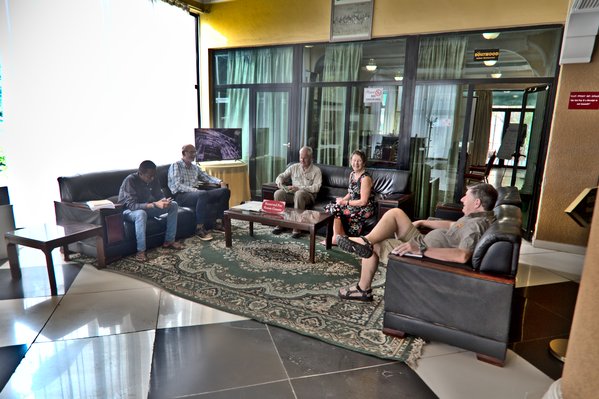
Our first sight of the complete group in the hotel lobby. Kede (tour
leader) and Andrew on the left we'd met on arrival at the airport,
but Robin, Jan and Phil were on different flights.
We're off to have a little spin around Dire Dawa, and in particular,
its rather curious railway station.
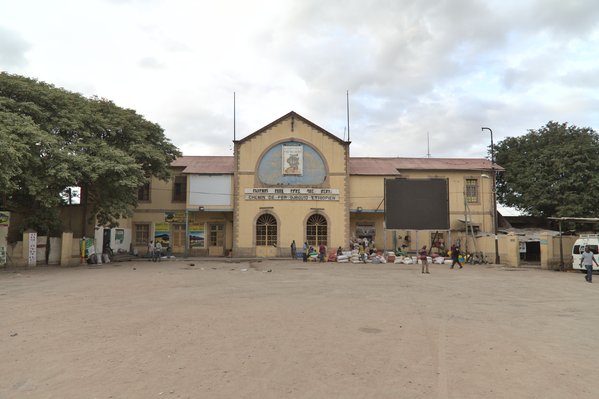
"CHEMIN DE FER DJIBOUTI - ETHIOPIEN" reads the text that's too small
to make out at this resolution.
The original railway was built by the French between Djibouti and
Addis Ababa back in the days when the former was known as French
Somaliland. It's mostly fallen into disrepair now, although
partially restored, and it has a lot of interesting relics slowly
rusting away.
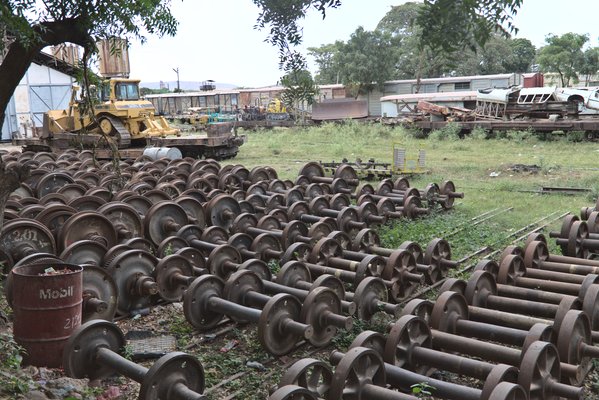
Need some wheels for your wagon?
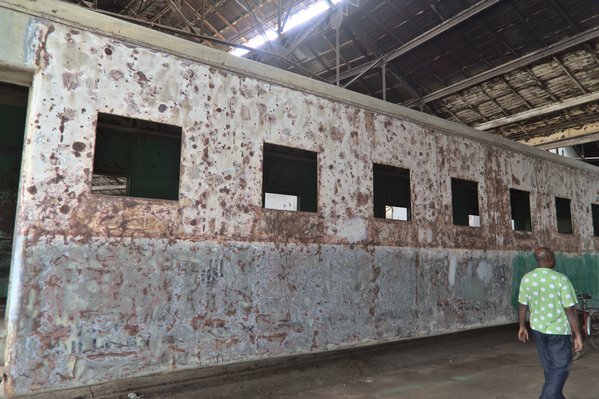
Hmm... I think this wagon needs more than just some wheels...
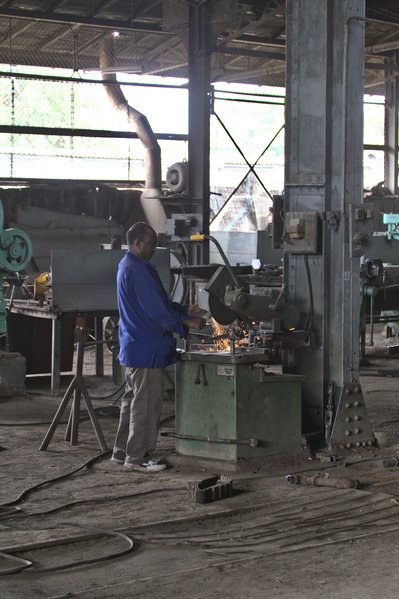
But the workshop is still in use, if not a shadow of its presumed
former self.

This, despite superficially resembling the contents of the
graveyard, is a real live train which will be off to Addis soon.
It's being stocked with beer now.
25 January 2020
To the ancient walled city of Harar.

Pretty chaotic, as you can see. We will go around in a few
circles before we finally reach our guesthouse, local knowledge
notwithstanding - Kede is a Harar boy himself!

Just because you can scarcely move for crazy tuk-tuk
drivers hurtling at you from every direction at once, that's no
reason not to lead your donkey down the middle of the road.
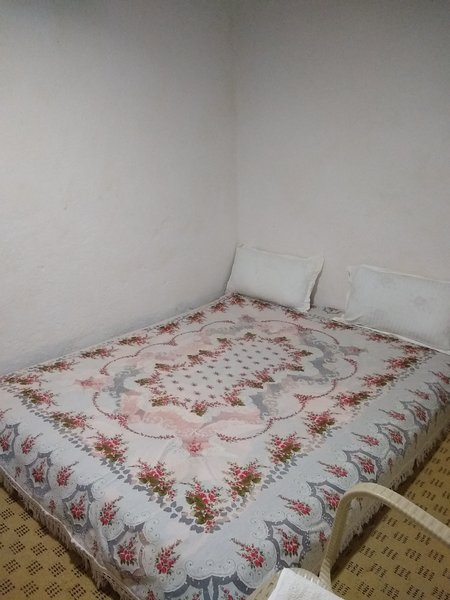
It has to be said the rooms are a bit basic.
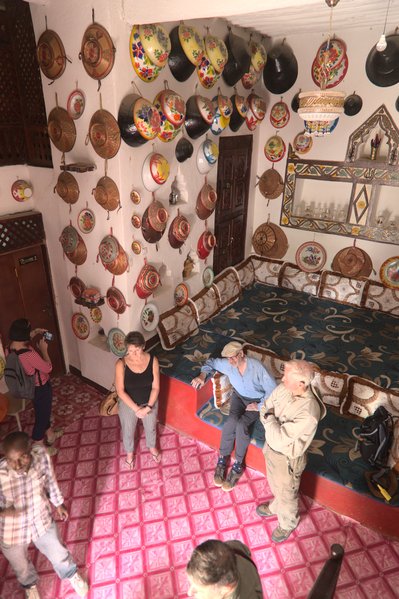
Although the communal area is more interesting. Not that we will
spend much time there.
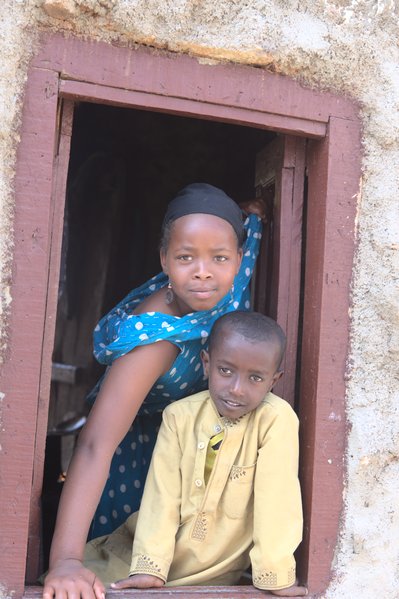
As we found on our previous trip, the kids just love to be
photographed. Even though mobile phones seem to have become quite a
lot more common, they're still often very primitive by our standards
(rather like my own phone as it happens) and it's far from the
modern Western norm where essentially everybody has a decent quality
camera with them 24/7.
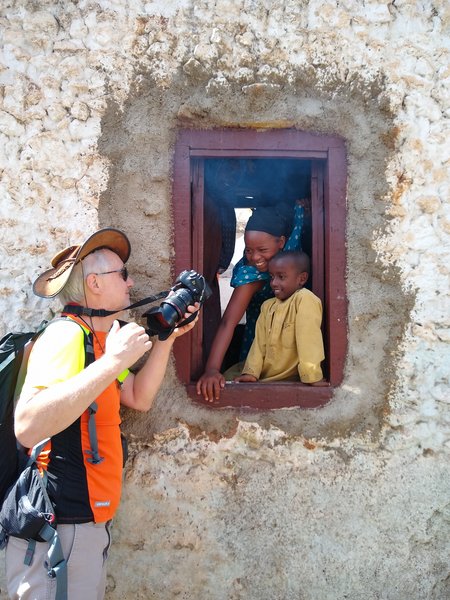
So they are ecstatic when you show them themselves on the screen,
because for so many it's still an exotic treat.
Off to the market now.
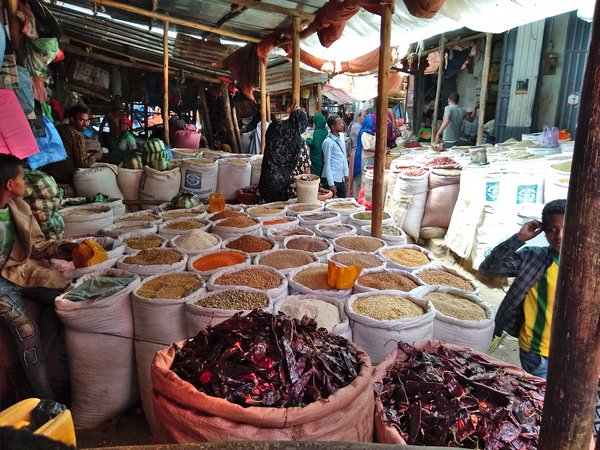
Huge sacks of pulses, beans, spices everywhere.
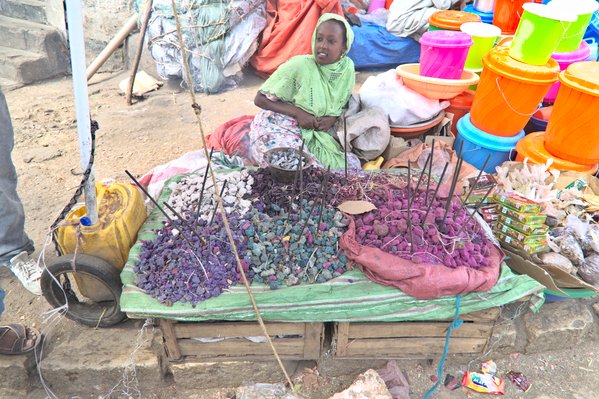
This lady is selling multicoloured incense.

And Amanda needs a closeup.
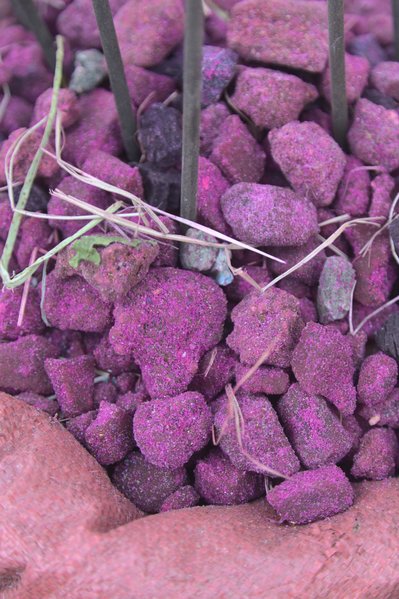
Like this.
Unlike the children, adult women of the Afar aren't so keen to be
photographic models.
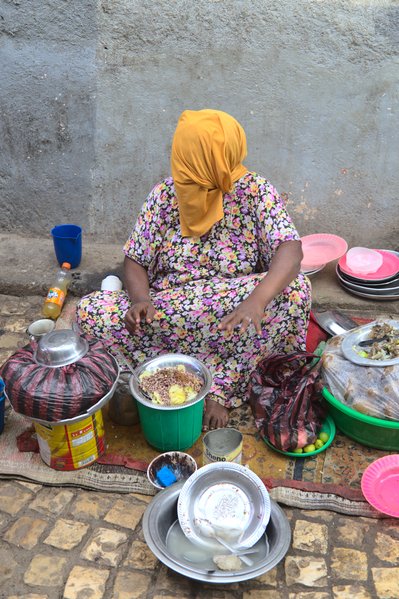
When I ask if it's ok to take her picture, she's fine so long as I
give her a moment to cover her face!
Adult men though, are more varied. Some make it very clear
that they don't like the idea at all...
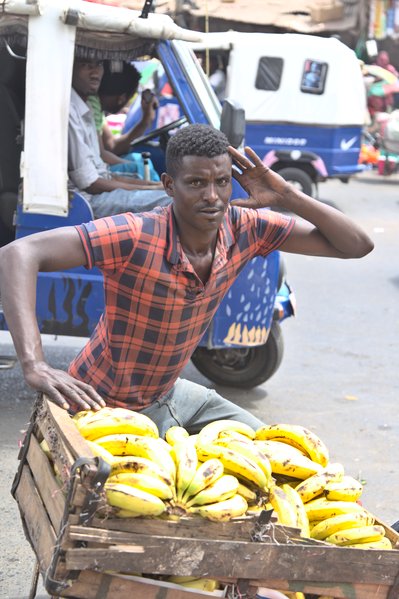
...while some virtually demand it!
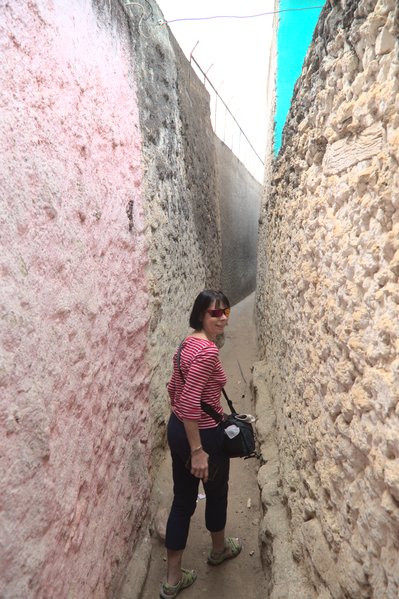
This narrow passage is apparently an ancient traditional tool of
reconciliation! Because it's not wide enough for two people to pass
in opposite directions without touching or squeezing hard against
the walls, when two people who have some kind of beef walk in from
opposite directions, they have to be co-operative to get through,
and then they can both thank the other for their politeness and
henceforth live in sweetness and harmony.
I'm not wholly convinced it's an infallible method, but it sounds
very civilised.
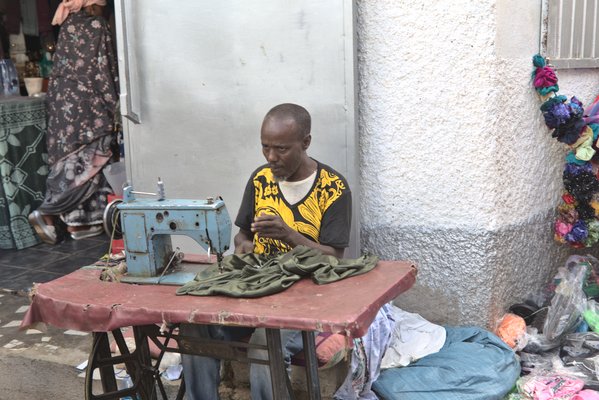
In the street of the tailors, men sit at sewing machines, busily
making, mending and altering clothes. I don't know if things like
spinning thread and weaving are women's work, but sewing machines
are definitely boy's toys.
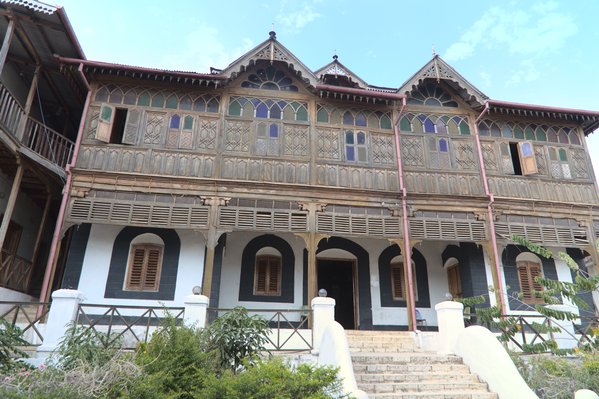
How are you on French poetry? Familiar with Rimbaud's work?
No, neither am I.
Rather worryingly, Wikipedia tells us:
In May 1871, aged 16, Rimbaud wrote [...]
I'm now making myself as scummy as I can. Why? I want to be a poet, and I'm working at turning myself into a seer. You won't understand any of this, and I'm almost incapable of explaining it to you. The idea is to reach the unknown by the derangement of all the senses. It involves enormous suffering, but one must be strong and be a born poet.If you know what he meant, do let me know. Actually, on second thoughts, don't.
But this is the house he lived in during his time in Ethiopia (Abyssinia as it was then) and it's now a museum.

The ceiling which looks like painted canvas is actually painted canvas!
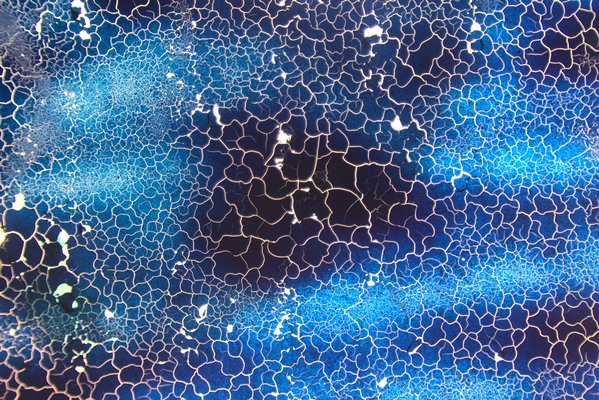
The individual panes of glass basically divide into clear and not-clear, but the latter encompasses a huge range of different techniques: bulk-dyed, stained, painted, embossed/moulded... you name it. This is one of my favourites.

Back in town, there's a man feeding the kites and encouraging the tourists to have a go. Well obviously I have to try it, and hold my kite food aloft. They're big birds and they come in at a fair old clip with some serious talons extended, but they're bloody accurate and barely even scratch my hand.
Amanda takes a turn but looks distinctly pleased when it's over.
Earlier when talking about the planned events, we'd asked Kede if there would be a coffee ceremony, as it was such a feature of our previous trip. He said no, it wasn't part of the plan, but perhaps one of the places we were going to visit would be able to do it for us. But he's been thinking and realises that he can take us to visit his extended family and one of his aunts can perform the ceremony.
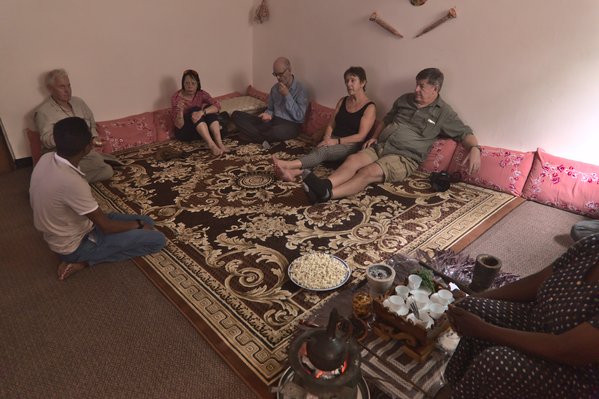
Not sure we look entirely at home here...
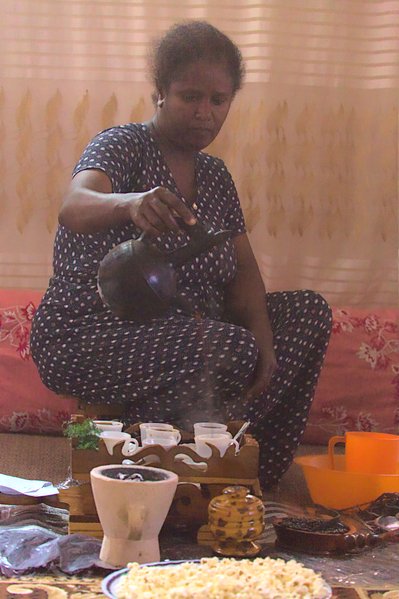
The coffee is ready.
After coffee, it's time to feed the hyenas. Well obviously.
There is, it seems, a tradition in Harar of feeding hyenas just outside the city wall, although as the city has expanded in recent years, the hyena-feeding spot has moved further out.
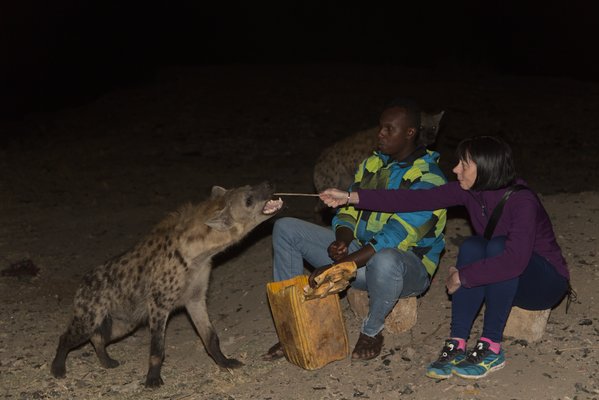
Like feeding the kites earlier, audience participation is a key feature.
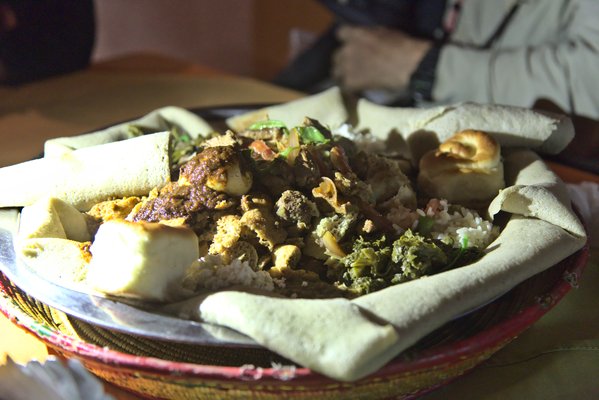
And finally, we feed ourselves.
26 January 2020
Mainly on the road today, heading for Awash National Park.
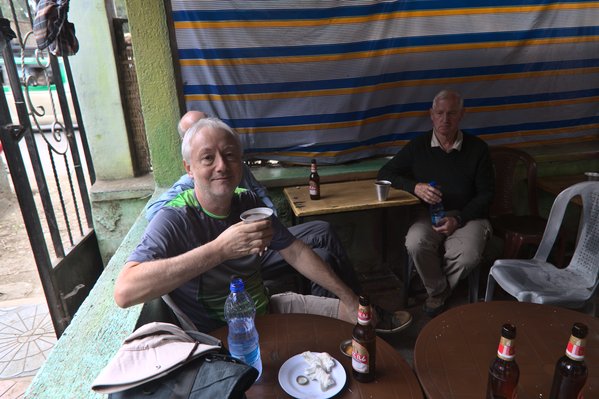
Lunch at a roadside cafe.
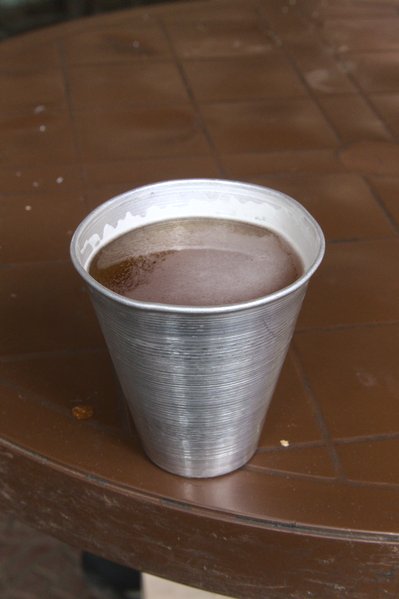
And for a change, draught beer by the glass; or more precisely, by the aluminum cup!
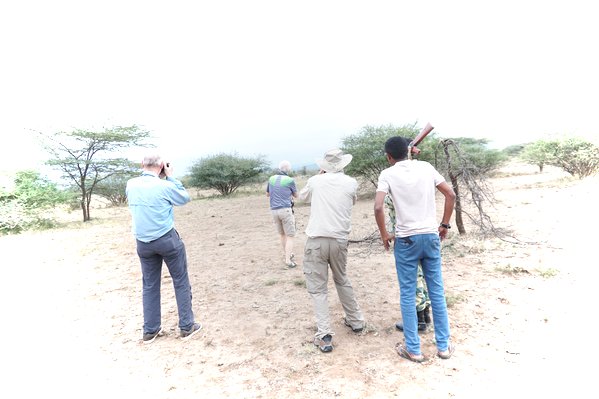
Amanda's camera was accidentally on an overexposed setting for this, and then my computer software decided to re-apply corrections that the camera had already made itself and brighten the edges still further to compensate for nonexistent vignetting. It's technically a cock-up, but I like the result so I've not fixed it!
We're in the National Park, looking at some oryx here,
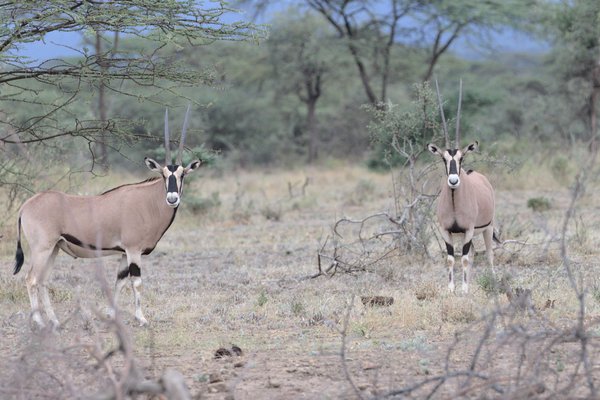
These two, for example.

A beer by the fire at the Awash Falls Lodge before dinner.
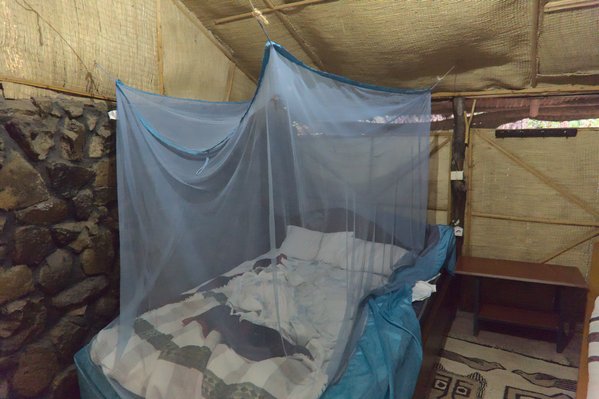
And pretty plush accommodation too. The net is not just for show, but we've been lucky with the mosquitoes so far.
Ok, when I say "plush", I don't mean hot showers or anything like that, but hey, a cold shower is better than no shower...
27 January 2020

Awash Falls, from which the lodge takes its name.
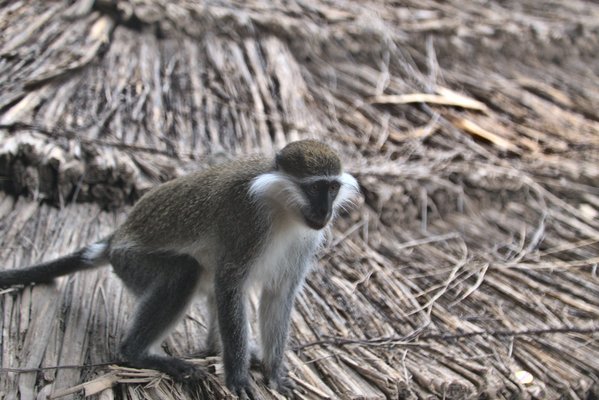
"Do you know there's a baboon on my roof?"
"You hum it, son, I'll play it."
Ah, the old ones are always the best, aren't they!
No? Ok, the old ones are always, err, old...

The lookout tower is a bit rickety!
The WF notes say the park has "seen better days", and we can't find any reason to disagree with that. A large part of the problem is that when it was first established in the 60s, it was a classic top-down government initiative which completely failed to appreciate the needs of the local people. This kind of place just can't work without community buy-in, but we gather that things have improved in the last few years and so maybe there's hope for the future.
Right now, though, I don't think it's worth a special trip if you aren't already going in that general direction, and places like the Simien or Bale mountains are much better choices if you want to see Ethiopian wildlife.
Back on the road now, to Semera, on the edge of the Danakil. We'll generally be following the course of the Awash river, although it's mostly not visible from the car.
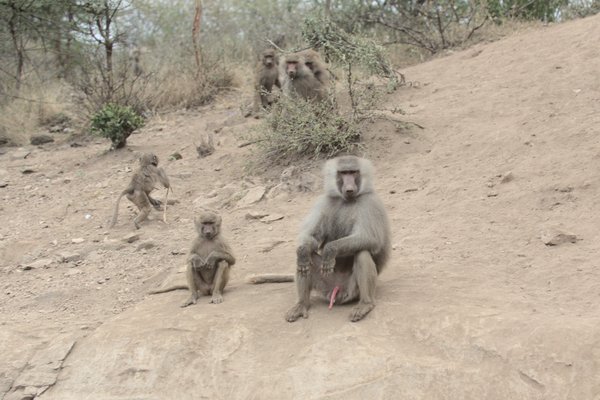
Now that is manspreading. I don't think #metoo has reached the Hamadryas Baboon community yet.
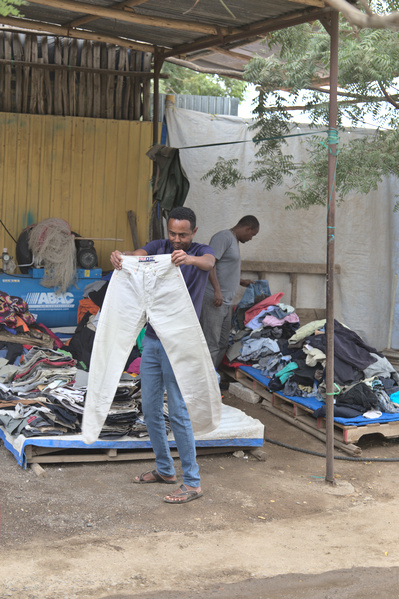
Just outside the cafe where we stop for elevenses is one of the places where your charity clothes donations end up. We really ought to be ashamed of chucking out stuff that's near-as-dammit new the way we do, but until then, there are plenty who are happy to benefit from our profligacy. In the end, Kede decides the trousers are not for him, though.
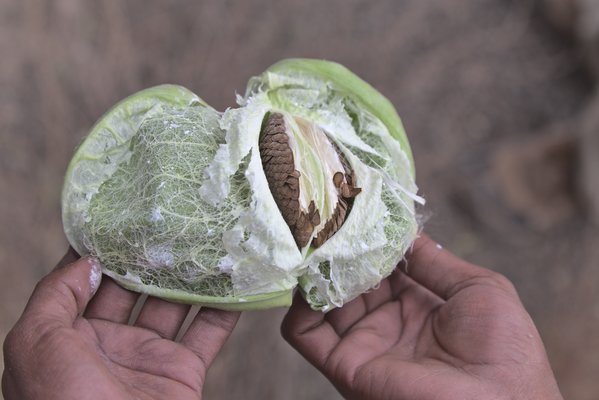
This is the inside of the intriguingly named "Sodom apple". From the outside, it looks like a solid fruit a bit like an unripe papaya, but touch it and it feels weirdly spongy. Inside, it's mostly air sacs with a central seed core, and when it's ripe, it explodes to disperse the seeds. The sap is mildly toxic and resistant to being washed off with soap, so you want to be careful touching it.
PS, don't confuse this Sodom apple, Calotropis procera, with the totally unrelated Sodom apple genus Solanum. See https://en.wikipedia.org/wiki/Apple_of_Sodom_(disambiguation) but GOK why three fruits that don't grow anywhere near the biblical city of Sodom take its name.
[Work in progress: trying to come up with a witty story whereby Jamaican Rastafarians with their Ethiopian roots came to Hungary, where they joined the Navy and established a tradition of Rum, Sodom apples and Goulash...]
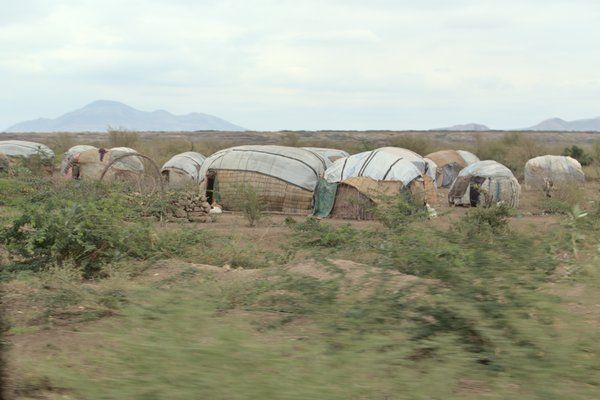
Slightly blurry through the vehicle window as we pass, a nomadic Afar camp. The huts are made from woven palm leaves and canvas over wooden frames, although plastic tarpaulins sometimes feature now.

Lunch at the Sheraton Hotel!
I think it was at the Park Lane Sheraton, many years ago, where I was involved in organising a trade event, and my colleague David and I were sitting in the lobby bar having a break. He remarked how heartwarming it was to see that all these busy businessmen could nevertheless find the time to give their nieces a special treat.
I'm not sure the nieces would have been so grateful to be taken here, but it's good enough for the likes of us!
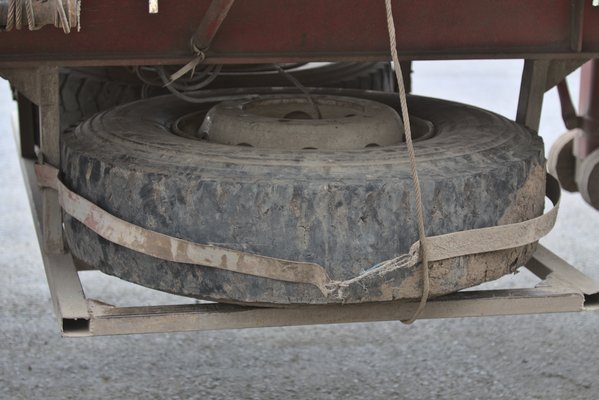
Hmm.... I'm not sure I understand why a commercial truck needs a racing slick as its spare...
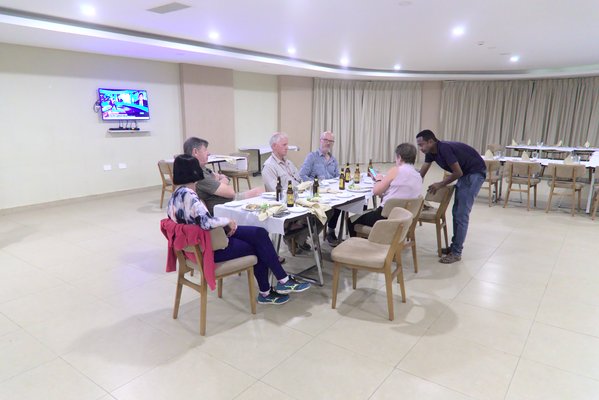
After the luxury of the Sheraton, the warm Olde Worlde charm of the Semera Kuriftu.
This hotel is still a bit of a construction site, and it's a long way from living up to its pretensions, but apparently it's still superior to what was previously the best in town! The WF notes clearly predate its establishment, and suggest that we might even be camping tonight in the event of there being no room at the inn, but the only thing thing this place has that's fewer than guests seems to be staff.
To be fair, it could actually be quite a decent place, albeit a bit soulless, with a few relatively minor improvements. Hot water would take them 90% of the way on its own!
28 January 2020
We will continue along the approximate course of the Afar river heading towards Lake Afrera. This is properly into the Danakil, and we'll be something like 100+m below sea level.
Except that first, we're going in quite the opposite direction!
It's another departure from the itinerary we were given, but we're going to visit the town of Asalta and see the markets there, and a camel market in particular. On the way, we'll also pass though a nature reserve.
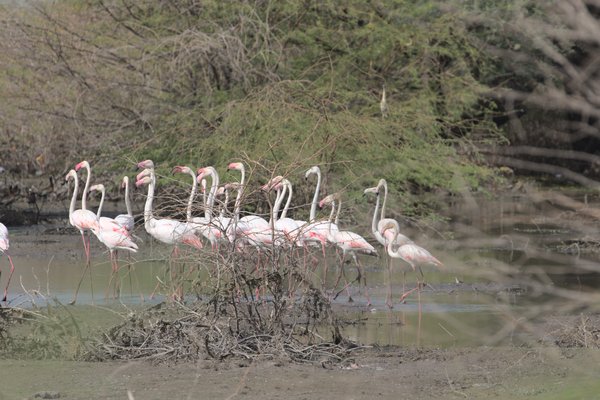
Right by the road there are some pools full of flamingoes and other birds.

I think these are White-faced Whistling Ducks, although they show no signs of whistling for us.
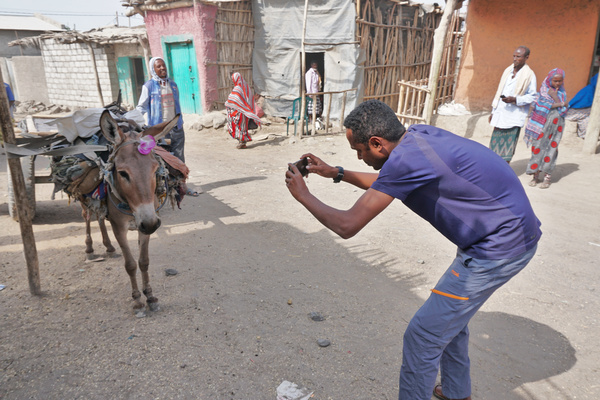
If you're going to the Danakil Depression, be sure to wear some flowers in your hair. Even if you're a donkey.
We reckon that if Kede thinks it's worth a photo, then it must be a bit out of the ordinary.
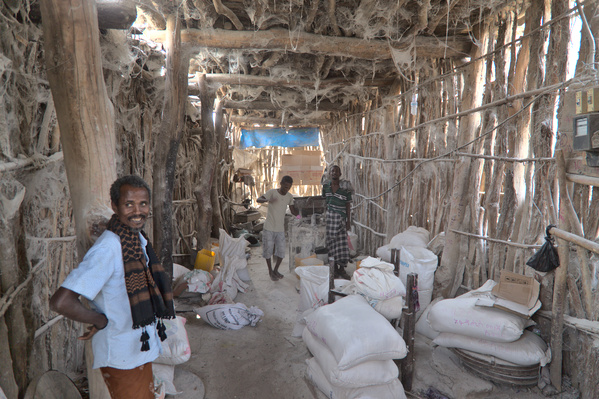
A flour mill.

This isn't the camel market, just camels in the market.

We watch a blacksmith at work, making an axe head.
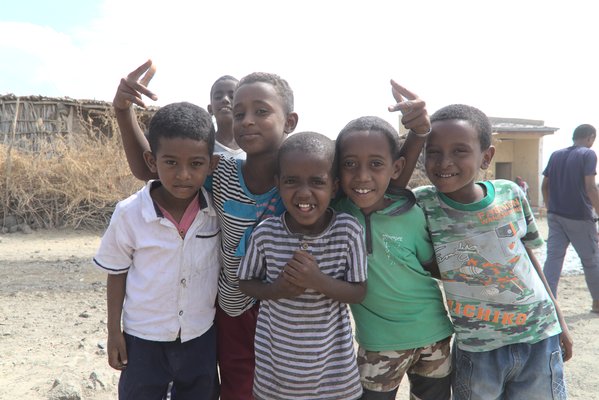
Once again, the children love to be photographed. Some young girls want to be models too, but their mothers won't let them. I don't think it's just me...
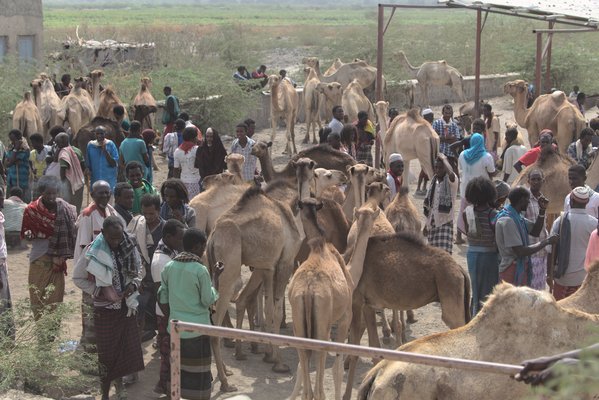
This is the camel market itself. We're told it's ok to photograph from outside, but we probably shouldn't try to go in. Nevertheless, one of the little boys takes my hand and tries to bring me in as his guest. The adults make it very clear that this is not on unless I give them money!
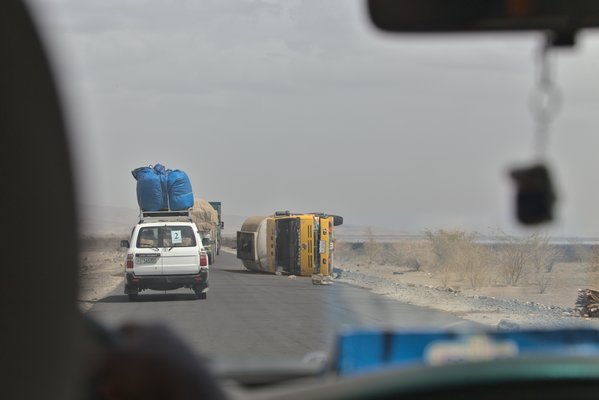
Ok, back on the road. This is a disturbingly common thing to see.

These cairns represent burial places for Afar warriors.
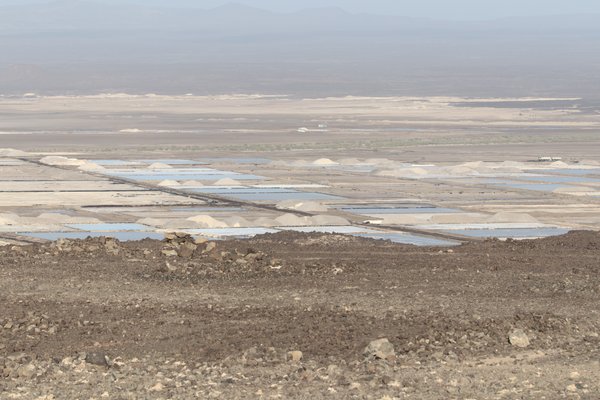
From a hill just before we descend to Lake Afrera itself, we look down on the lake and the salt pans that surround it.

And as evening falls, it's time for a little dip. This water doesn't have the same level of salinity as the Dead Sea, but it's pretty buoyant. However, you do still feel you're in the water as opposed to the peculiar sensation of being on it, and almost in danger of falling off.
Afterwards, there's a shallow hot pool to lie in, but the only pictures I have of that contain images that I fear are too unflattering for a public blog!
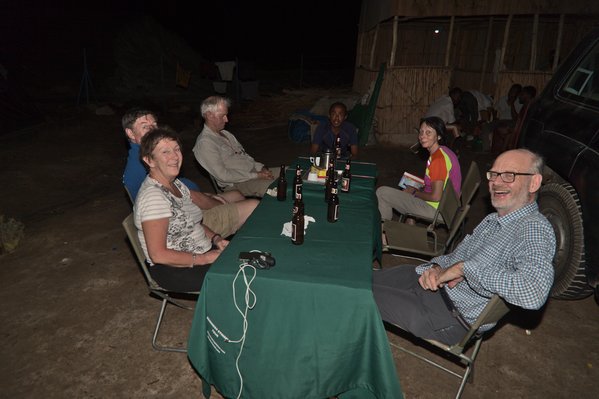
We have to drink the beer before it gets warm. No refrigeration outside of town!
29 January 2020
To Erta Ale...

The campsite in the early morning. The green tents in the picture aren't actually ours; ours are just a tiny bit posher, though there's not much in it. The wind is quite strong, though, and these tents seem to be particularly swaying in the breeze.
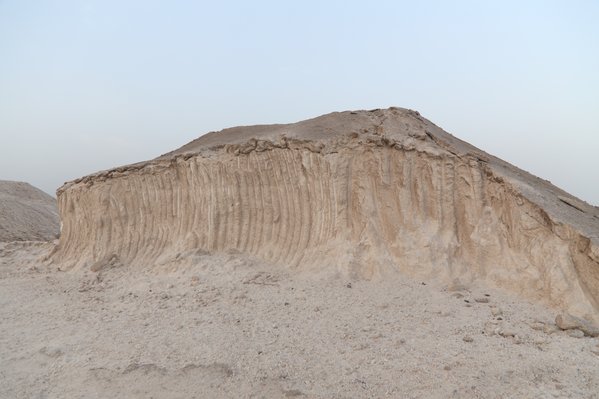
This is a salt hill just behind the camp. It looks like it's been half removed with a mechanical digger, but there are no immediately obvious signs of ongoing work.
We now have a bit of a guided tour.
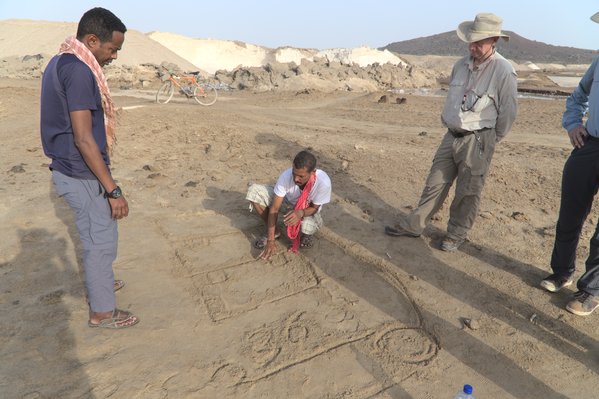
Our local guide explains how the salt pools work. They use a three-pool system, increasing the salt concentration at each stage until it's ready to harvest.
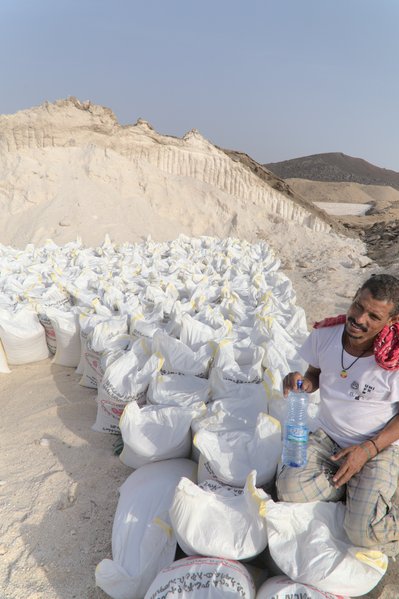
It gets packed into sacks which will then go to the refinery.
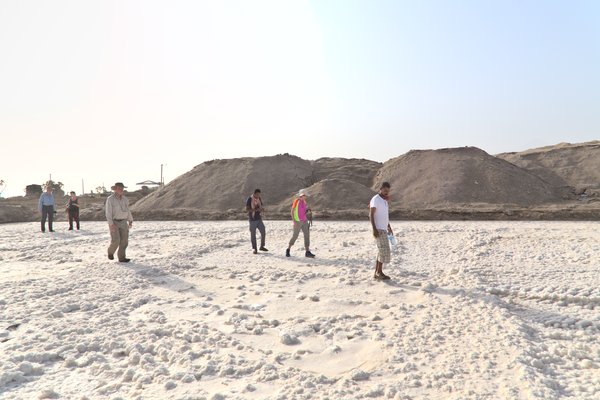
The final stage pools are easily solid enough to walk on.
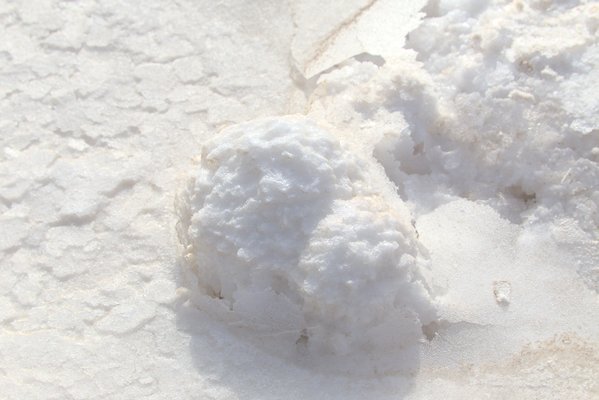
I'm not sure why the hills are so comparatively dirty when this salt is almost pure white. Certainly there's a lot of dust around, but I don't understand why it would settle on the hills but not the flats.
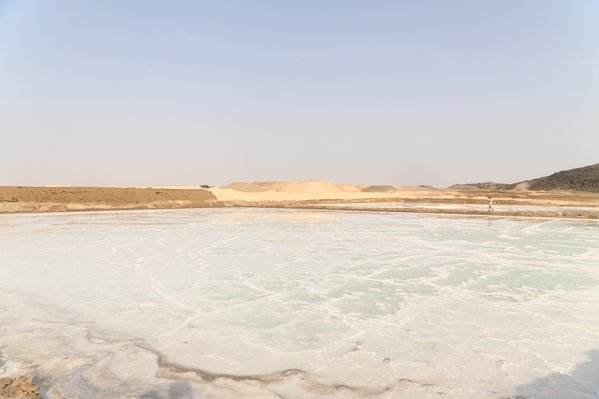
The earlier stages are more of a salt crust floating on the water. You wouldn't be well advised to try walking on that!
We walk a little further into town to meet up with our vehicles and have a brief stroll around.
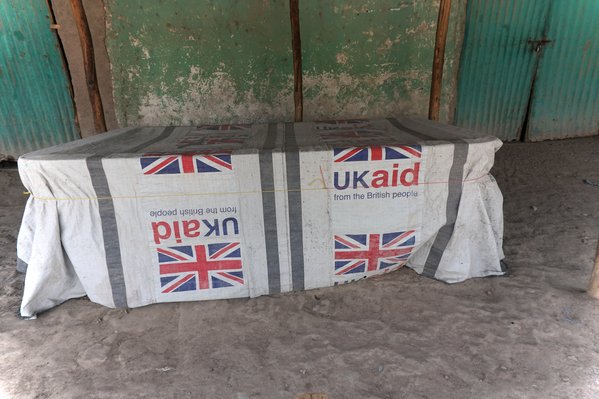
I bet you didn't know that we sent them tablecloths!
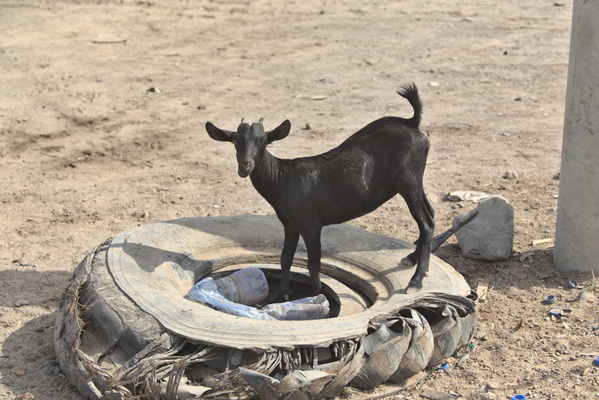
Even by the most optimistic standards, this tyre would probably no longer pass the local MOT, but the goat doesn't seem to mind.
And off we go. The road and the place we have lunch aren't much different to previous examples, so we'll just skip straight to our destination.

Here they are: our luxury villas at Erta Ale basecamp.
This is a new camp, a lot closer to the volcano than the old one, so again we diverge a bit from the schedule we were given. We'll stay overnight here instead of trekking up to the crater rim camp, which instead we'll do first thing tomorrow. That means we can set ourselves up for the night while it's still light rather than having to mess about in the dark after a long walk.
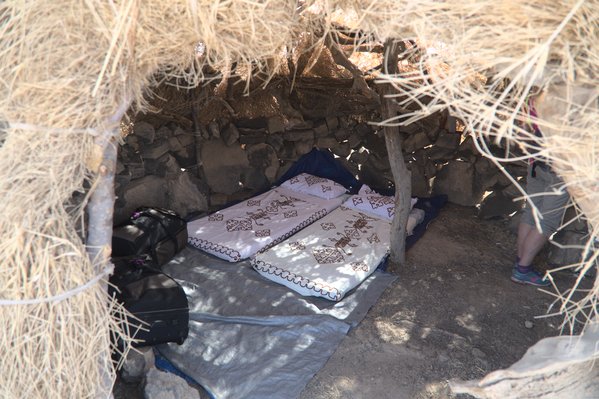
As you can see, we have all mod cons.

The roof may leak in the rain, but that isn't usually much of a problem round these parts. Ironically, there has indeed been some unseasonable rain recently, but as a visitor one would be hard-pressed to notice.

Well that's a slightly different view from the room.
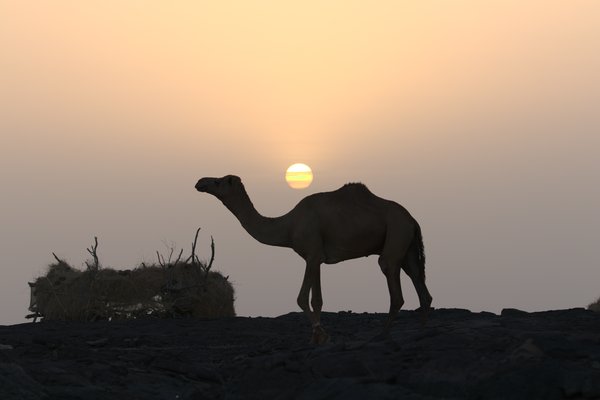
Midnight at the oasis? Well, kind of if you confuse standard and Ethiopian time. See, it's about 6pm by conventional local time now, which makes it 12 o'clock Ethiopian!
How is this? Well, being near the equator, sunrise and sunset don't vary much across the year, and day and night are never wildly different from twelve hours each. The traditional Ethiopian clock, therefore, counts twelve daylight hours and twelve nightime, so "12 o'clock" is basically sunrise or sunset, not midday or midnight. People who work in tourism or international trade are pretty used to switching between systems as a matter of course, but even then you may be given an Ethiopian time by mistake.
Of course, the Ethiopian calendar is different too, and even more so. If you want the gory details, I suggest Wikipedia - https://en.wikipedia.org/wiki/Ethiopian_calendar - but apart from year numbers which (currently) vary by seven or eight from the Gregorian, there's less scope for confusion because the month names are totally different.
This is not a good place for the camel-phobic, and even if you're not, it may be a touch disconcerting to find one sticking its head in through your doorway or sounding like it's nibbling at your roof.
30 January 2020
Time for a climb!
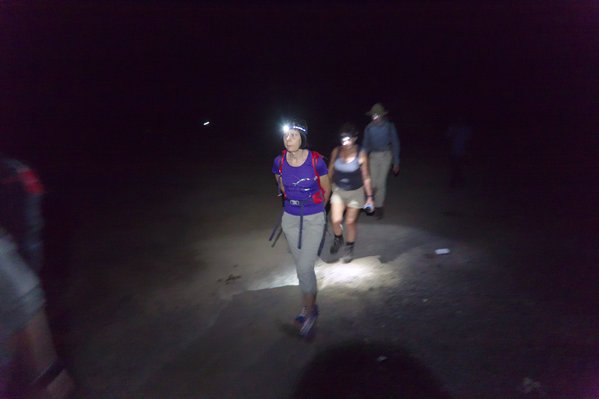
We set out well before daybreak, with no moon, so head torches are the only source of light.
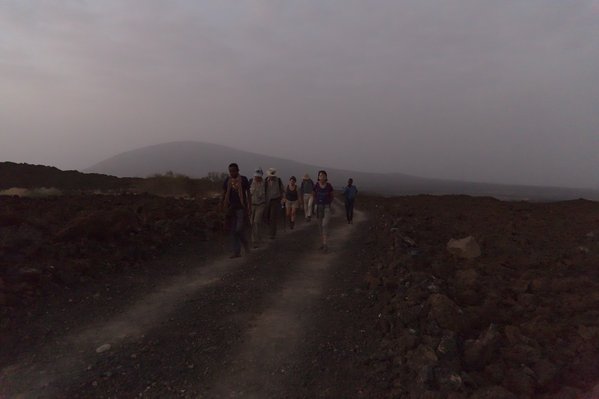
It gets light enough to see by about 6:20 am (conventional time, of course).
The first half of the trek is fairly flat and follows a rough 4x4 track so it's quite easy. We have a bit of a climb ahead of us, but we're told it's not that steep or difficult.

The camels carrying our equipment and supplies set off earlier, but are slower, so we overtake them on the way.
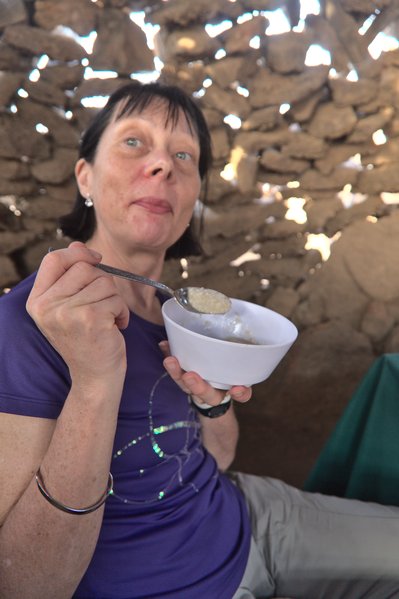
And at the top: breakfast! Maize porridge, which would probably not get high marks on Four in a Bed, where anything less that a Full English, preferably overflowing the sides of the plate, will see marks deducted. Then again, they'd be deducting marks for traces of dust, less than perfect plumbing and being disturbed in the night by camels, and no doubt there'd be some serious underpayments on the final day! No idea what I'm talking about? https://www.channel4.com/programmes/four-in-a-bed .

Our schedule gives us some free time after breakfast, so I go for a bit of a walk around the rim. Robin, I see, has had the same idea a few minutes earlier. The people coming down are an Italian group we bumped into earlier, but they seem to be on a tighter schedule. As my path crosses theirs, their leader tells me that one of the women likes my T-shirt and wants to know where I got it. Err, pass... Amanda bought it for me!
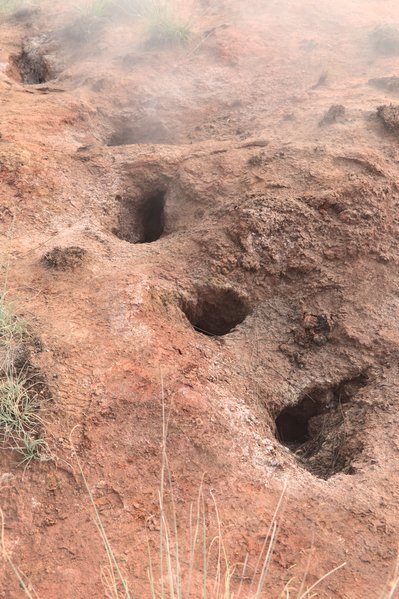
We've been warned about possible fumes, but this is just plain steam. Not a hint of sulphur that I can detect, even walking right through it. It's warm rather than hot.
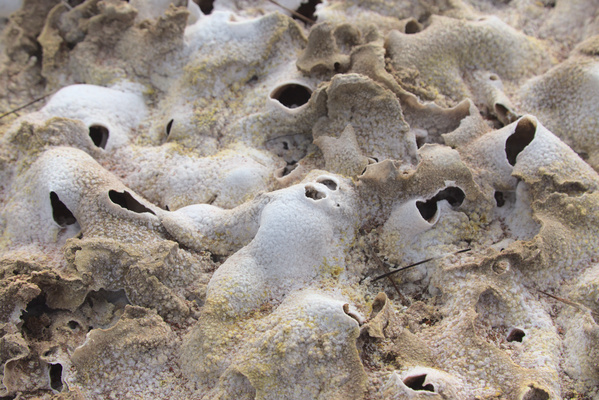
More strange mineral formations.

By the time we start our first guided walk, the wind has shifted a bit and we are now getting a little sulphur dioxide in the air. That's the one that chokes you: the bad-egg-smell gas is hydrogen sulphide and we don't seem to have any of that. In the absence of sophisticated respirator equipment, hold a cloth over your mouth and nose...
Earlier, Robin and Andrew (I think) were trying to remember their chemistry, and whether would be absorbed by a moist cloth or not. Sadly all that dredging for forgotten knowledge has proven irrelevant in the absence of said
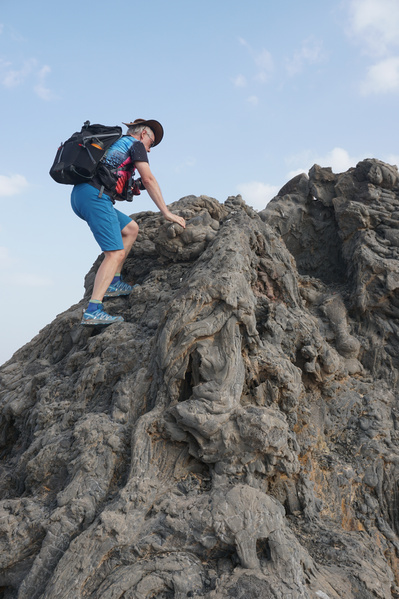
Oh look, a bit of rock sticking up. I shall climb it.
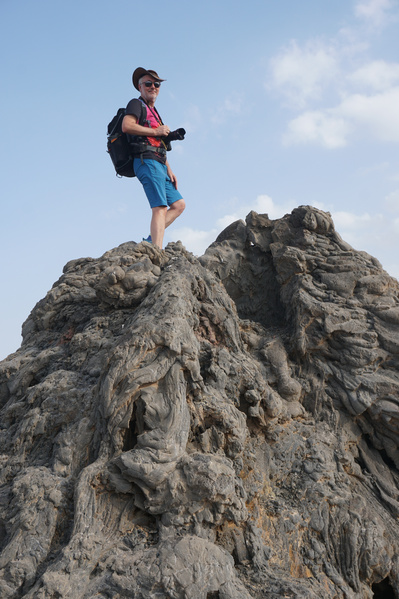
But nobody else cares to follow. I shall just have to come down again.
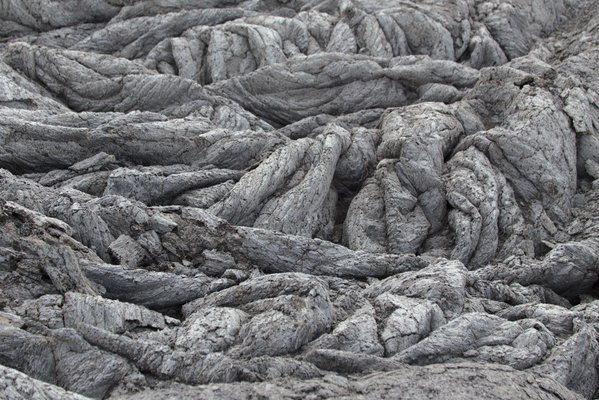
The volcano is still active, and this lava is only a few years old.
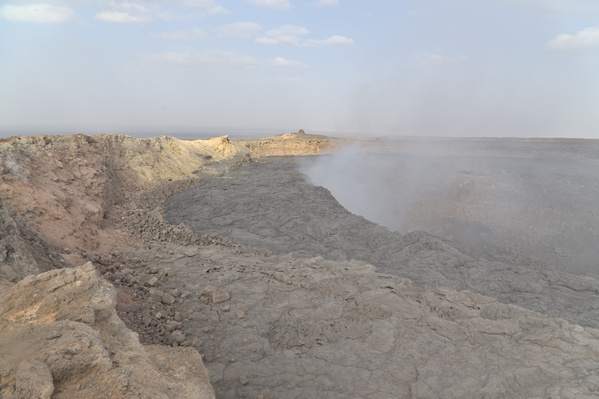
The different shades of grey represent different erruptions. Older lava is paler than newer.
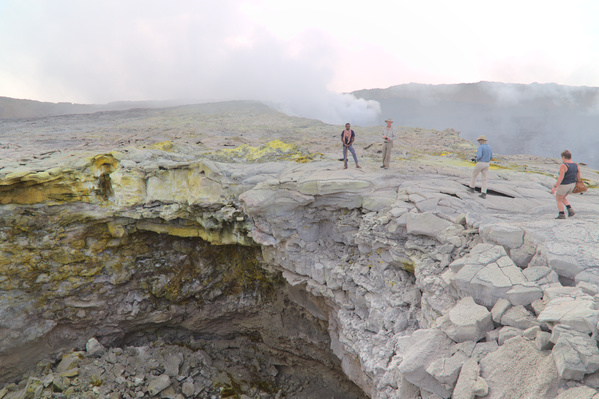
More steam and sulphur-yellow rocks at the rim.
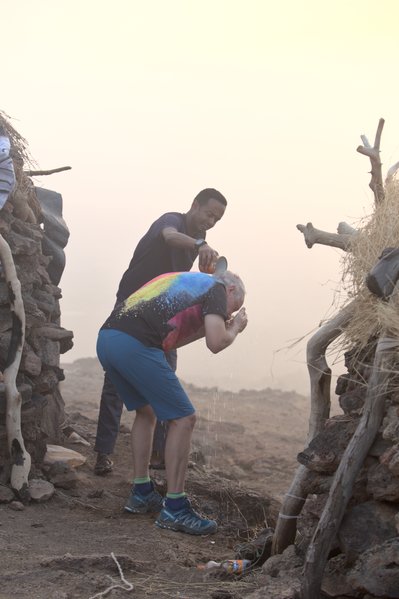
Back at camp, Kede is offering to help people wash their hair by tipping a jug or two of water over their heads. It works better than you might think, although not if you think it would work really well.
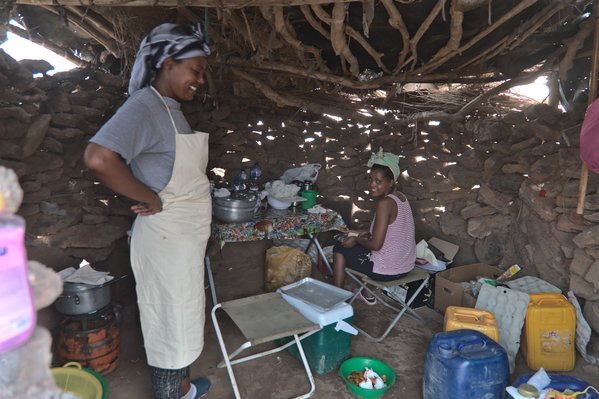
Maski, our cook, and her assistant whose name I am ashamed to have forgotten (although she was only introduced to us very briefly), are preparing dinner in the kitchen. It is, you can see, every bit as lavishly appointed as the accommodation.
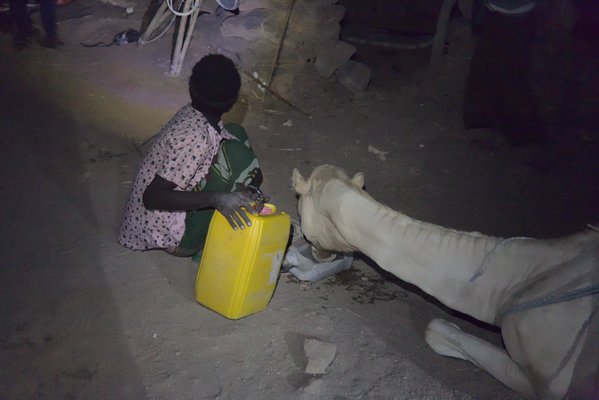
Some water by torchlight for a thirsty camel.
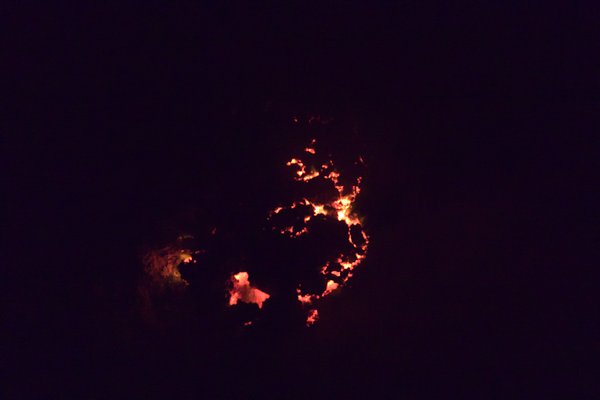
The lava lake is going through a bit of a quiet phase at the moment, so there's not that much to see. In daylight the glow is completely invisible, and in truth, this photo is a bit misleading as it's just a small area seen through a big zoom lens.
Our local guide is impressive. In pitch darkness apart from a small torch, he leads us right to the rim of the crater without any hesitation. Unaccompanied, I fear that we would just go round in circles if we were lucky, and fall in if not.
31 January 2020
In the morning, we return to base camp before setting out for Dallol.
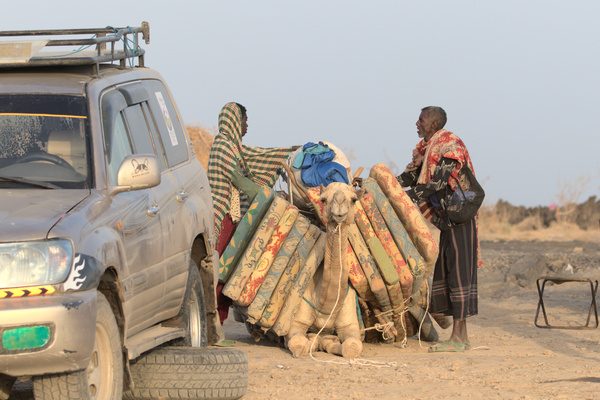
The camels bring the gear back.
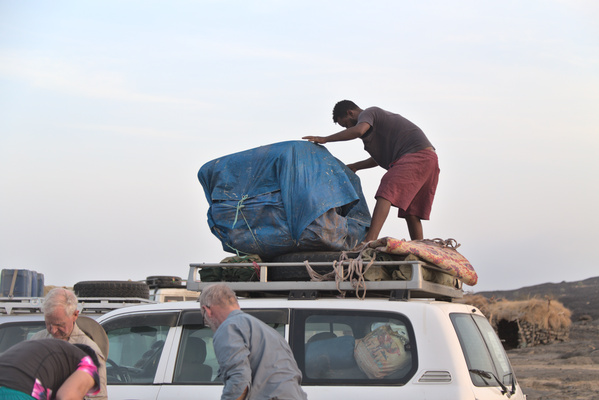
And it's reloaded onto the 4x4s.
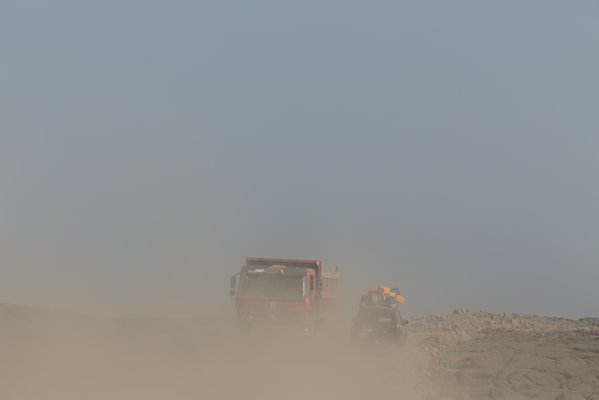
In places it's pretty dusty, and Chinese trucks come hurtling down the road towards you. As in so many developing countries, the Chinese are building new infrastructure like there's no tomorrow, presumably on the basis that having half the world owing them a few favours could be a useful thing. The road we're on exists primarily to service the real new road they'e building.
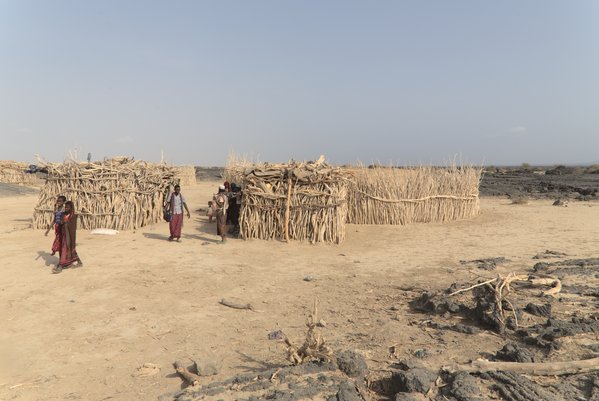
In the middle of the desert, we stop to visit an Afar village.
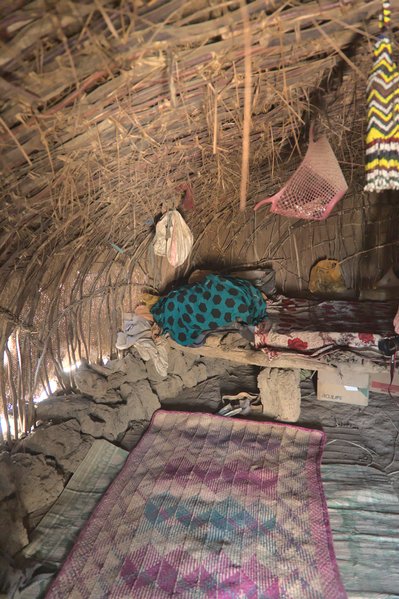
You can see that the hut is constructed mainly from thin branches and palm leaves, but with a ring of stones at the base. The people are nomadic and the huts will be taken down again in due course, but the foundation rings remain for their next return.
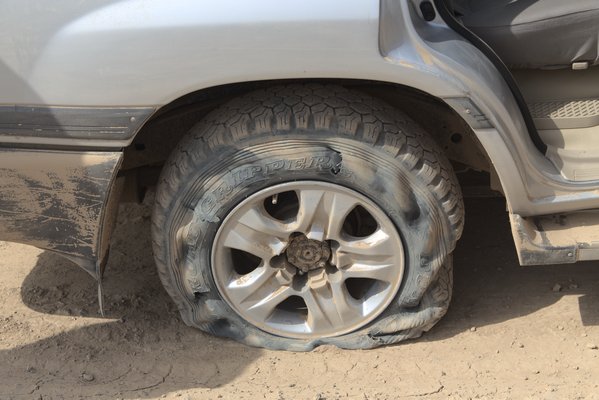
Ah, we have a bit of a technical problem.
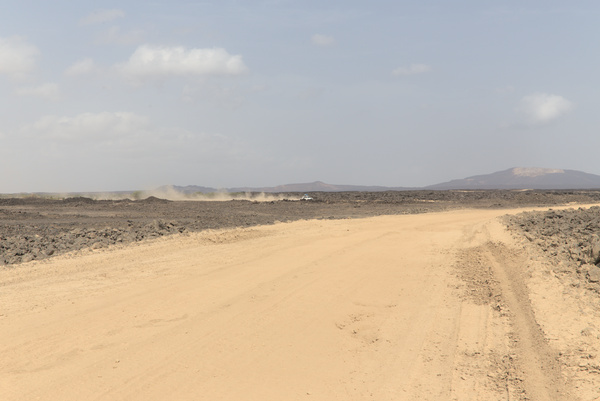
Kede in the lead car has noticed we've disappeared and is on his way back. But as you can see, there's not a lot else around, and I don't think the AA have much of a presence. Good job we've got not just one but two spare wheels.

Another low-tech washing solution.
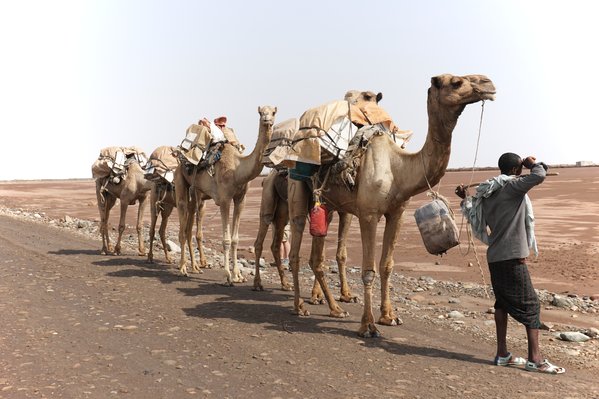
As we approach the salt mining area, a camel train passes us.

More and more, though, the salt miners are taking to using trucks, which can carry far heavier loads than camels.
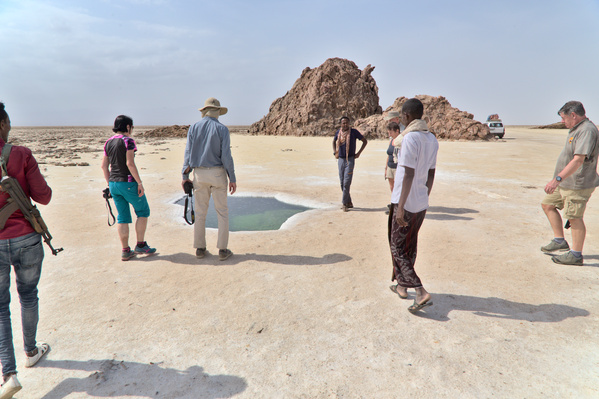
In places, holes in the salt crust create green pools.
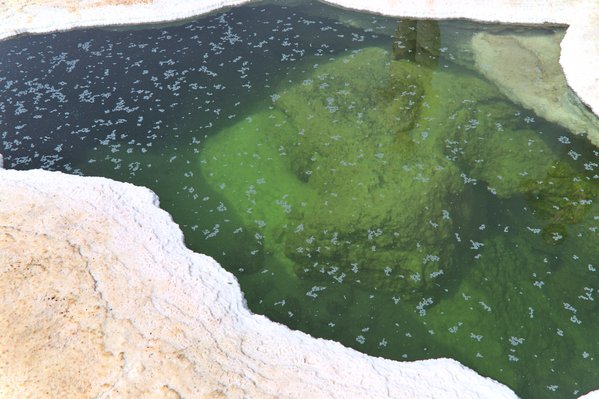
The green colour is not fom algae but is chemical in origin. While we normally think of iron as giving rise to red colouring in a landscape, the geochemistry of Dallol is sufficiently exotic that greens and yellows can form too.
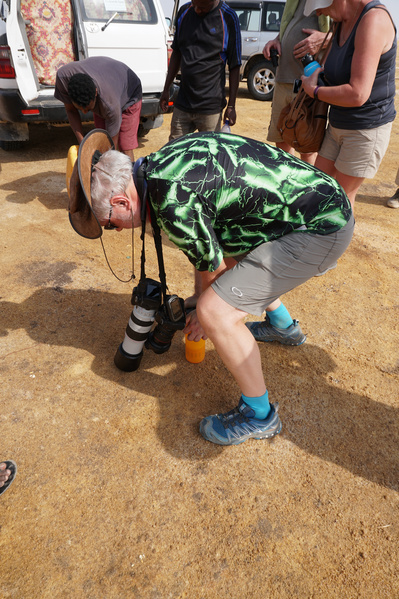
A momentary digression. Remember in the first picture I was holding a filtered water bottle? As well as that, we also bought a "Grayl Geopress" which has a very different design. Instead of filtering as you drink, which means you have to squeeze and suck quite hard to get a decent flow, with this one the filtering is a completely separate operation. You fill an outer vessel with impure water, then press down an inner vessel that contains the filter and has a piston-like seal. It takes a few seconds, but then you have what is in effect simply a bottle of pure water. You can drink it, pour it, whatever, without any further effort.
Now to be fair, it costs a lot more than a conventional filter bottle, and it's noticeably bigger and heavier, but I'm 100% sold on the design. Amanda, by contrast, took one look at it and declared it too bulky, so she stuck with the other one.
But the reason we're filling up is because we're now going for a walk. This may be the coolest time of the year here, and it's been a bit cooler than average anyway, but it's still bloody hot!
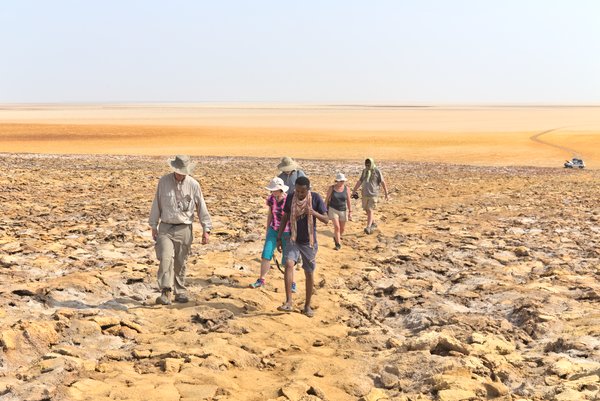
If you imagine just cropping the right hand side of the picture where you can see one of the cars and the track that led here, this is a vast and completely empty space.
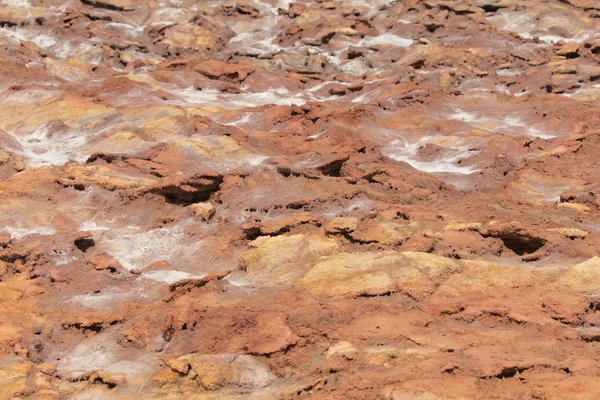
Not sand, not salt, not rock exactly... This terrain is the result of some pretty bizarre geophysical and chemical processes.
Before we arrived, I had been thinking, "Yeah, we've been to Iceland, we've been to New Zealand, we know what volcanic mineral springs look like", but that was wrong, wrong, wrong! This is like nothing we've seen.

Suddenly it's more like a mixture of salt and marble growing in patterns that resemble bracket fungus!

Different again.
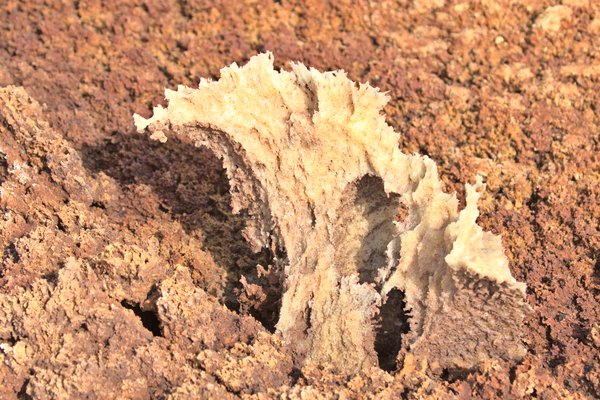
Another mineral form that looks somehow organic.

Wow. Just wow.
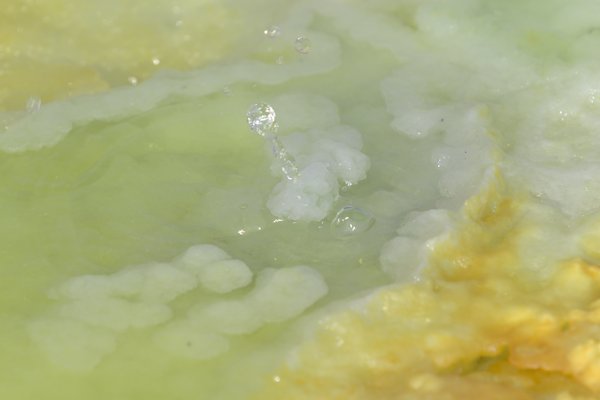
A tiny, tiny geyser?

No apologies for going a bit over the top on the picture count here. This place really is something special.
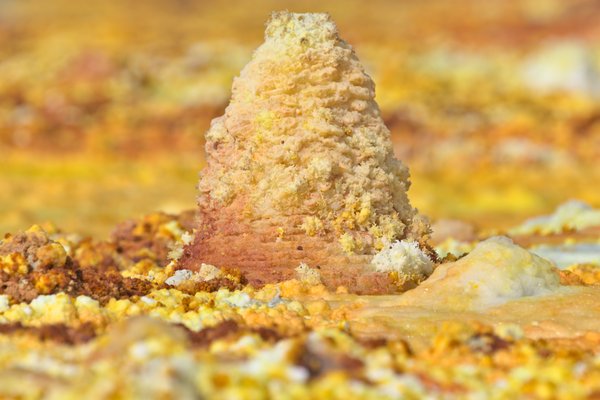
One other interesting fact about the pools here. They're totally lifeless. So-called 'extremophile' bacteria can live in the most unlikely places: boiling water, inside rocks, even inside nuclear reactors; but Dallol has so many extremes going on at once that nothing can deal with all of them together.
From Wikipedia: "anoxic, hyper-acidic (pH <0), hyper-saline (almost 10 times more saline than seawater), high temperature (> 108 °C) brines that contain more than 26 g/L of iron"
I didn't even know pH < 0 was possible!
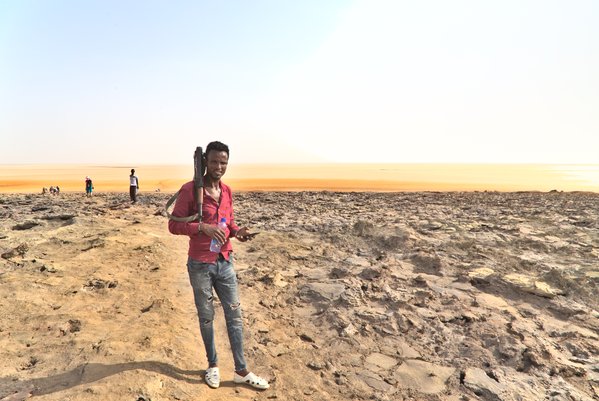
On the way back, one of our local guides asks me to take his picture. He's never been here himself, despite living in the nearest town.
We're not done yet, though. We have some very different geology to look at now.
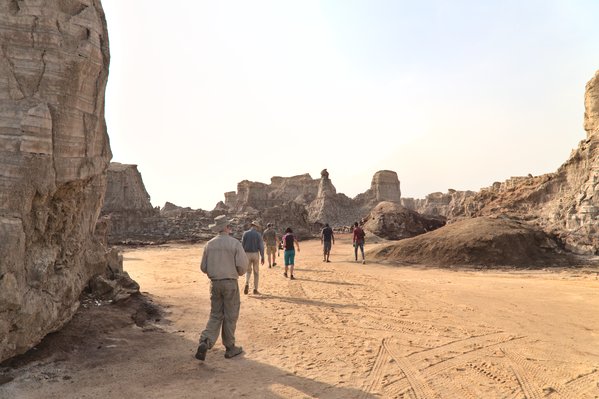
You can't help wondering if there's another Indiana Jones film to be made here! The Danakil may not be the most accessible place in the world, but it would make some amazing movie sets.
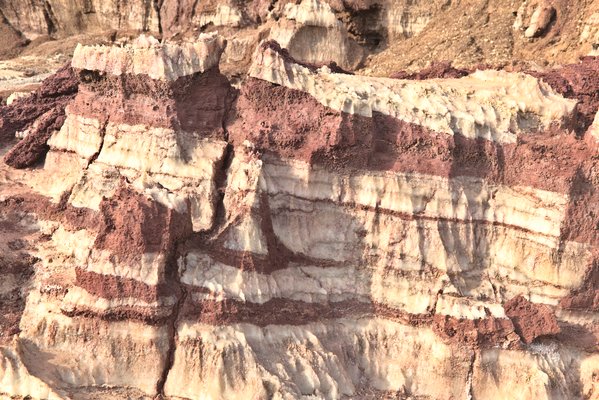
Like chocolate layer cake.

Or curtains.
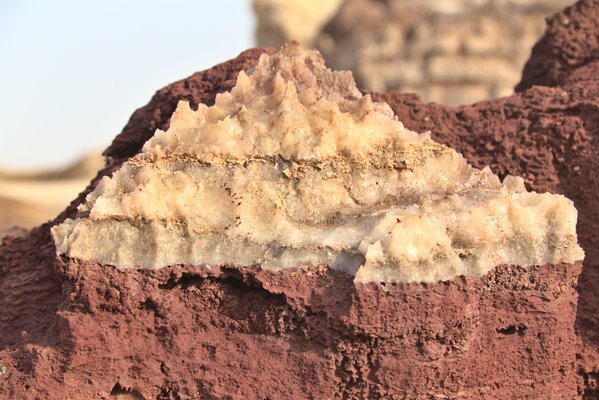
The icing on the top,
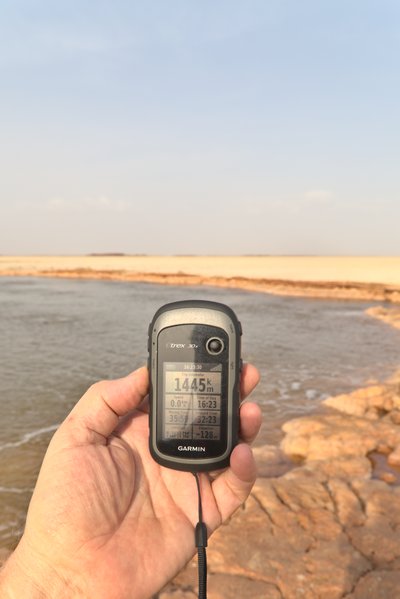
It's not quite clear in the photo, but the elevation is reading -128 metres. This is as low as it gets!
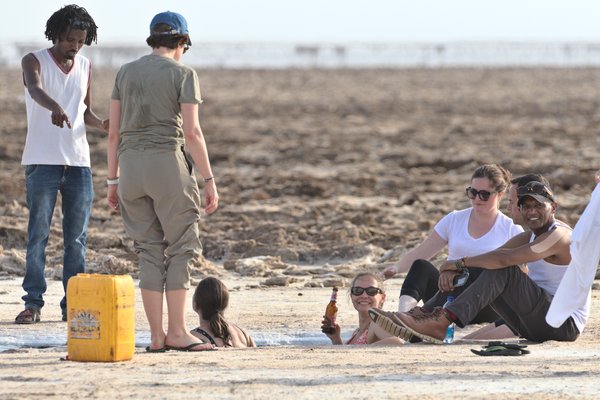
Remember the green pool earlier? Another group are taking a dip. I do slightly worry for Phil's blood pressure when he sees the girl in the bikini holding a beer. Not because of the girl in the bikini of course, but because of the beer!

As it's a Friday and most of the local people are Muslims, nobody is working the salt today, but these blocks are piled up ready for collection. We have a quick look, but we'll be back tomorrow to see them working. For now we're going to drive to the edge of a salt lake for the sunset.

I think you can tell what Kede's trying to do with his picture. We saw people doing exactly the same on the Bolivian salt flats.
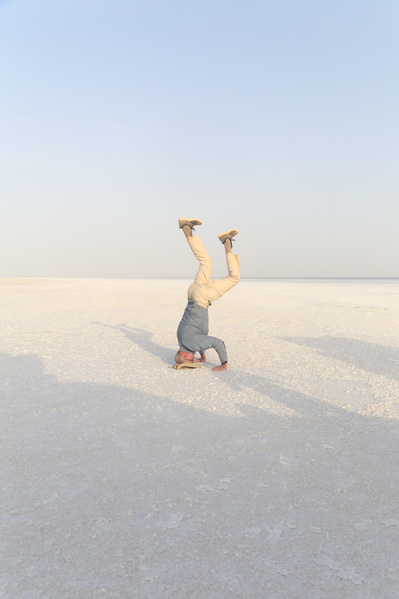
Andrew has a decent stab at doing a headstand, but can't actually keep his balance on the painfully rough salt surface.

A bunch of other tourists have parked upsun of us, rather spoiling the open view we had previously, but then thanks to the cloud, the sun more or less disappears at this point and there's no real sunset anyway.
1 February 2020
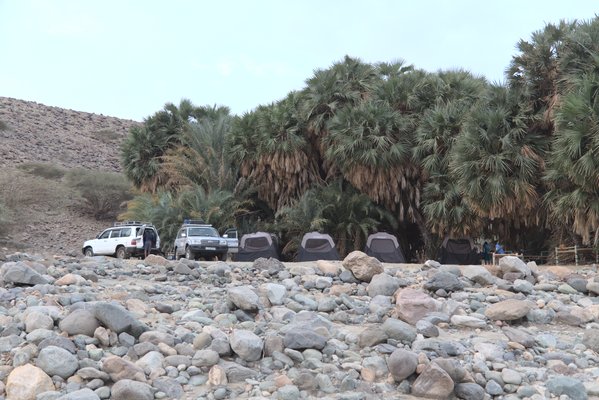
Our final camp
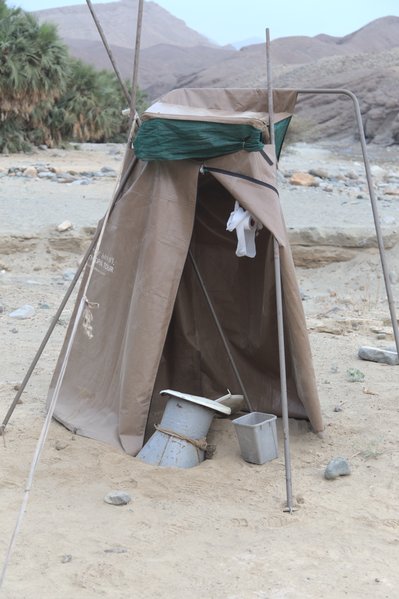
In theory we have a posh toilet tent with proper sit-down facilities. Unfortunately, the sand is really really dry and soft, and as soon as I sit on it, it starts sinking until I fall over! I try and restore it to position, but no joy. Dig a hole and the ground around it just won't take my weight, Apparently Amanda was ok earlier, but she's rather lighter...
So, back to the salt mines to see them digging it up.
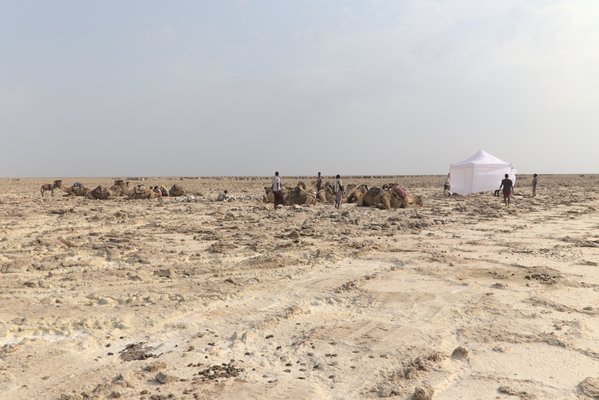
The marquee is a bit out of place, put up by another visiting group rather than the workers, although we're not quite sure why. Could be they're planning to stay a while, hence the need for some shelter from the direct sun. It's fairly early morning now, so not too hot yet, but that will change.
The process is hard work, with several steps.
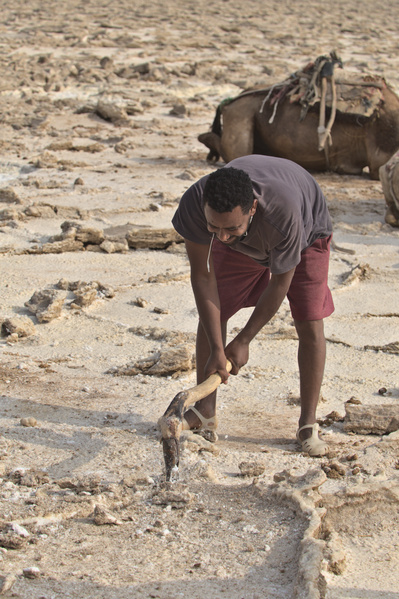
First, a man with an axe cuts channels dividing the salt crust into large segments.
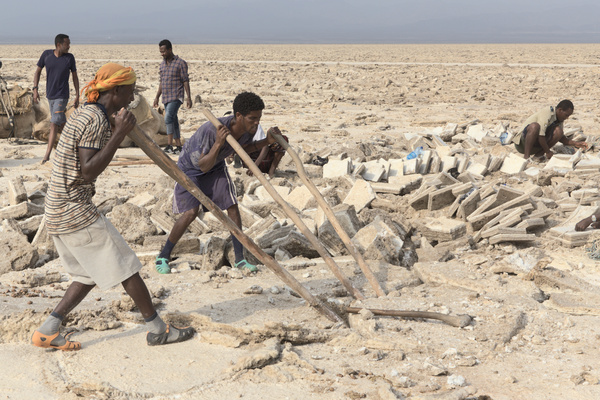
Then they use long poles to lever the sections away from the underlying soil.
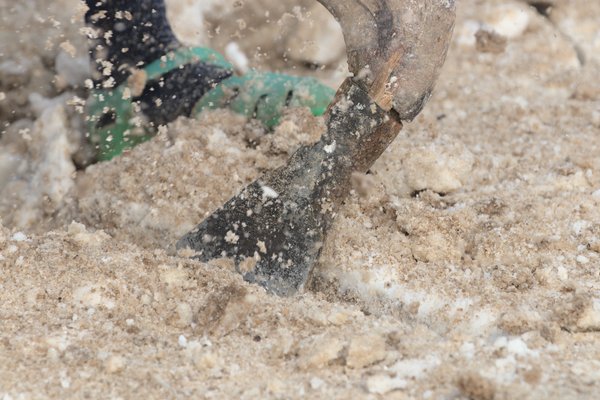
When the large pieces are freed, they're cut into rough blanks ready to be trimmed to a standard size.

As well as trimming the edges, this guy scrapes away the dirty surfaces front and back leaving fairly pure salt. Of course 'pure' is very much a relative term here: the blocks will then go to a factory to be refined before the salt is fit for consumption.
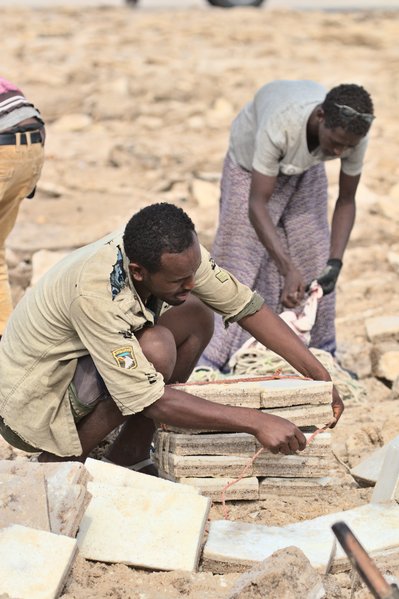
Then the blocks are tied into bundles which will be loaded onto the camels, as we saw in the earlier picture.

The camels can relax for now: they'll have their work to do later.
We've got just one more thing to see in the desert before we get to Mekele, which will be the end of the line and the start of our flights home.
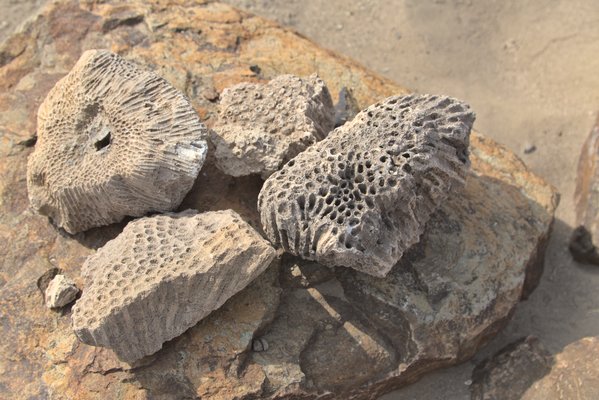
Fossil corals and maybe sponges from when this arid land was a sea, millions of years ago.
We stop at another small town for lunch and to say goodbye to our support crew, who'll be going back to look after another group this afternoon.
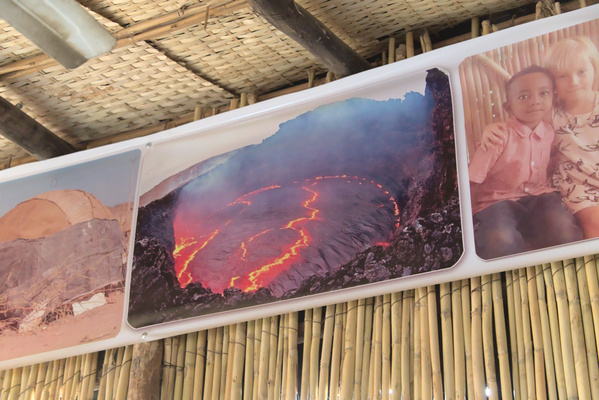
At the cafe, they have some pictures of the Danakil on the walls, including this shot of how the lava lake at Erta Ale can look. Kede says he's a bit disappointed we didn't get to see it like that, but I guess volcanoes pay little heed to the wishes of tourists and tour guides.
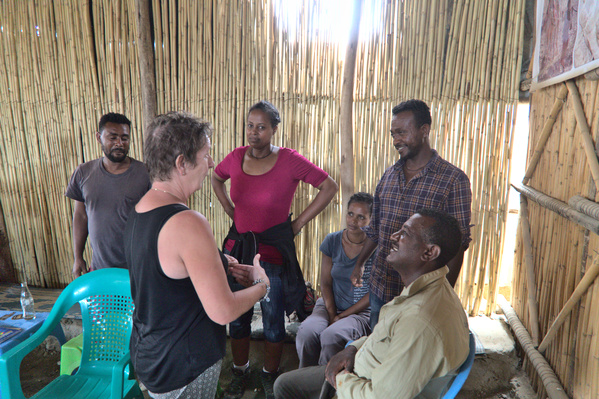
Although Kede generally takes responsibility for deciding on the tip amounts (after checking we're ok with each case), for all but trivial services he asks one of us to do the actual thanking and handover. Jan here is (IIRC) thanking the drivers.
But at this point I must confess my shameful faux pas. For some reason, Kede has given me two tips: one for now for Maski the cook, and one for later for the mandatory local police escort, whose services we haven't really needed but that's how it works. I make a little speech thanking her warmly and then give her the wrong tip! It's a lot smaller than hers, but I don't realise until we're about to drop off the policeman ten minutes later. OMG!!!
We race back to town to find Maski, who's been in tears at what she received, understandably so. I am so sorry, that was entirely my fault and should never have happened; she never deserved that. Hugs and tears all round and happiness is restored.
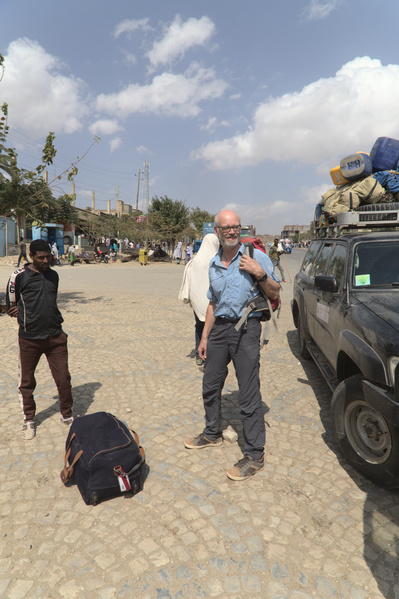
At Mekele, Andrew is continuing with his driver on an extension to see more of the country, on what sounds like a slightly shortened version of the group tour we did in 2015. The rest of us have a few hours at a hotel before catching our flights.
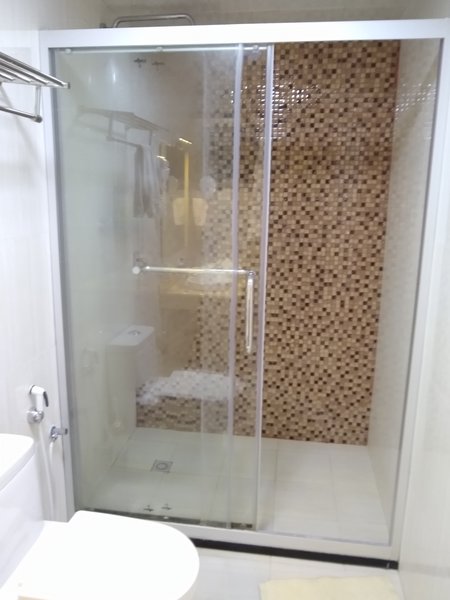
IT'S A SHOWER!!!
Mind, the water is barely tepid, but it's still a shower!
Theoretically there is a final dinner, but frankly we've had a long day today and there's a lot more travelling ahead of us, so we prefer to grab a couple of hours sleep.
Phil, Jan and Kede are all on the same flight back to Addis as us, but we're the only ones with a connection. You may recall that finding our way between International and Domestic on the way out was a bit of an adventure? Well the reverse is even more so!
It's not obvious to us what to do, and when Kede asks the local staff, they don't seem to know either. We wander around in circles asking people, getting different and inconsistent answers. It's not just us: there's a lady with children who appears to be an Ethiopian herself, because she's certainly not speaking English to the staff, and she doesn't seem to be able to find out either. After much to-ing and fro-ing, we seem to reach a consensus and manage to persuade the right person to stamp our passports and let us go back to - it turns out - exactly where we came in, to catch the bus to the other terminal.
We remain unable to figure out why an airport should have difficulty with the concept of international/domestic connections, but our flight times have allowed us plenty of slack so it hasn't been a real problem.
Finally, then, we are in International Departures, we have a gate, our flight is running to schedule, looks like all is well.
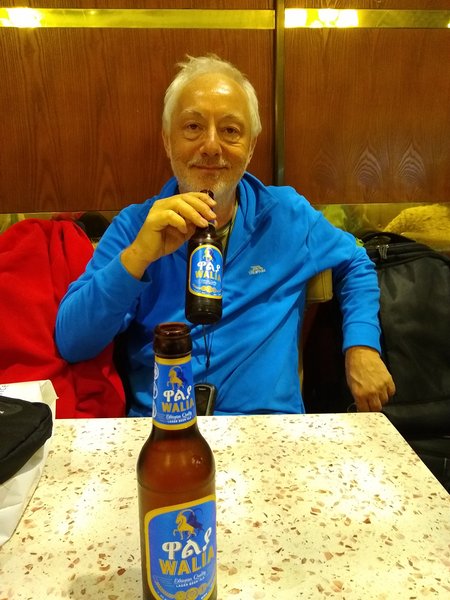
Ok, at Heathrow it was Chablis and seafood; here it's Walia beer and injera, but it's symmetrical enough in the grand scheme of things...
So: which are you?
Are you the sort who thinks, "You two are so lucky to be able to travel to incredible places like that, I am so jealous!"?
Or are you: "OMG going on holiday with you two would be like my worst nightmare times a million!"?
Whichever, I hope you've enjoyed reading about it :-)
Love to all,
Steve.